what do you hook up 5e3 ground switch to
[ How Amps Work ] [ Overdrive ] [ 5E3 Mods ] [ 5F6A Mods ] [ AB763 Mods ]
How the Fender 5E3 Deluxe Amp Works
By Rob Robinette
'5E3' was Fender's internal model designation for the 1957 tweed Deluxe. The February 1957 Fender price listing shows the Deluxe at $129.50 which is equal to $1,145 in 2017 inflation adapted dollars.
Fender 1957 Catalog
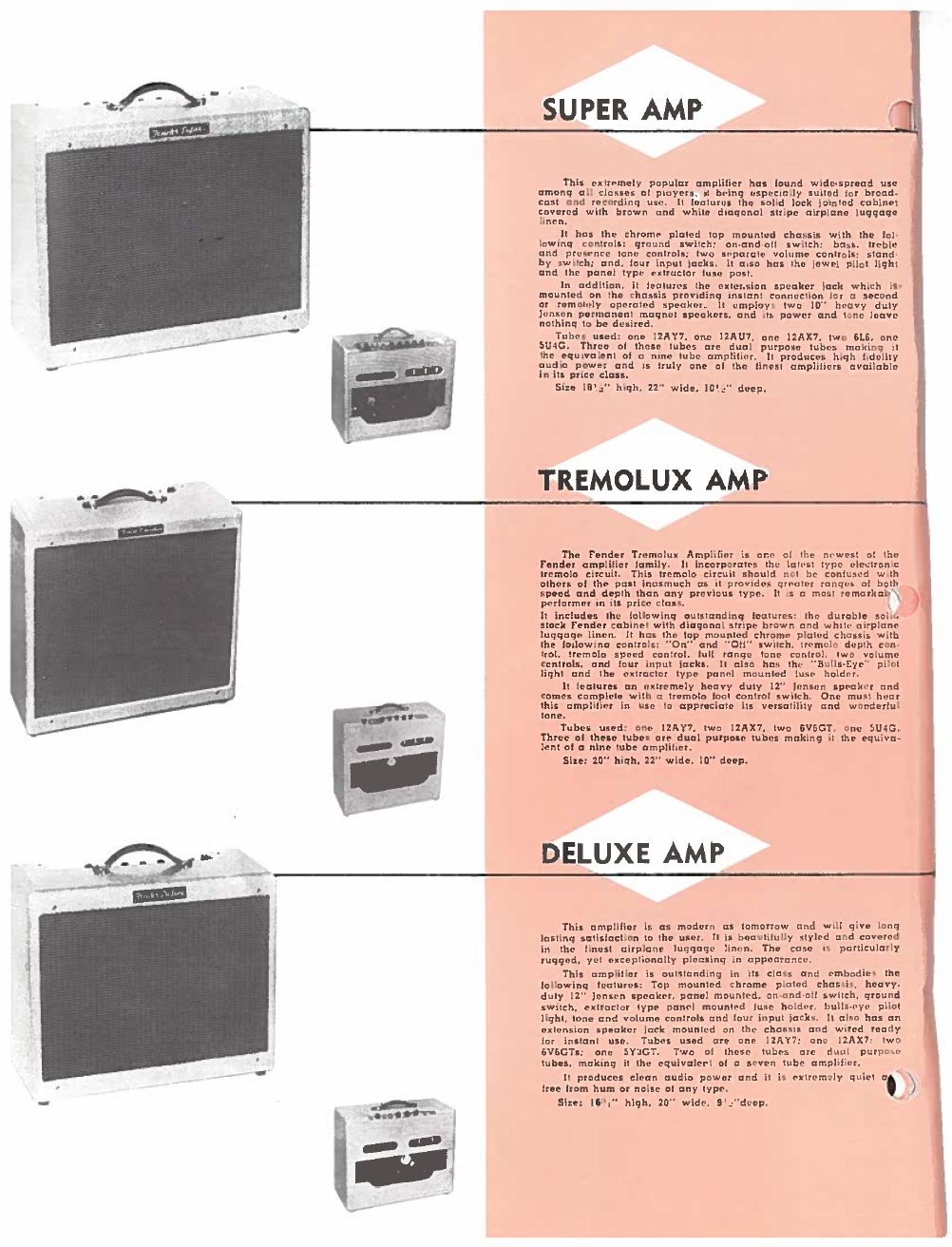
The Palatial retailed for $129.l
At that place were several other models of the 'Deluxe' simply the 5E3 is by far the most popular. The 5E3 amp kit phenomenon is still going strong so there's lots of new tube amp guitarists that would similar a not-too-technical explanation of how the amp works, what each component does, and how irresolute those components will affect the amp'due south voice.
I recommend y'all take a wait at my How Tube Amps Work and How Vacuum Tubes Work webpages for a detailed explanation how vacuum tubes piece of work in the very uncomplicated Fender 5F1 Champ guitar amp. I won't be going over tube theory and other introductory material here so check it out if you have problem understanding this webpage. For data on the evolution of the Fender Palatial and Deluxe Reverb circuit see this. If yous like to mod your amps check out my 5E3 Modifications webpage. I too take a folio dedicated to the magical 5F6-A Bassman amp.
The 5E3 Chassis
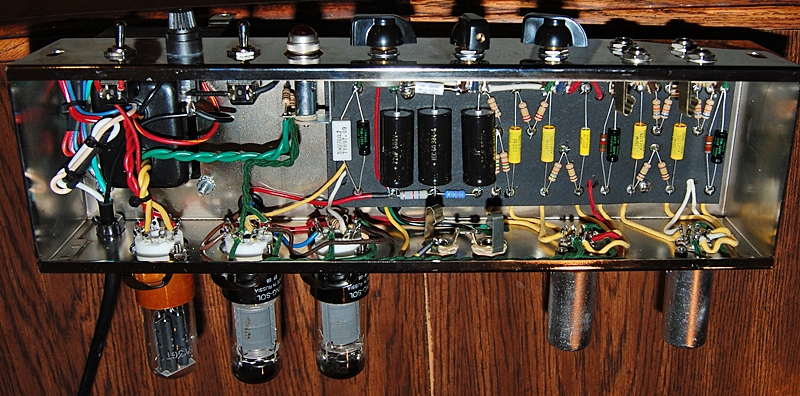
Controls on meridian, Circuit Board inside, tubes on bottom right to left: V1 Preamp, V2 Preamp & Phase Inverter, V3 and V4 Ability Tubes, and V5 Rectifier Tube at far left. The Ability Transformer and Output Transformer are attached to the other side of the chassis. Photo and chassis by Bob Arbogast.
Jump down to the Original 5E3 Photos Section to see what a real 1957 5E3 looks similar.
Some of the elements that give the 5E3 Palatial such a unique voice are its funky interactive volume and tone controls and information technology's raw, deep voice. Both volumes and the tone controls all collaborate to create some unique tones. Its rawness comes from both preamp gain stages having bypassed cathodes for maximum gain and with no negative feedback loop breakup comes on early on. This leads to little headroom, early dirt and a lazy transition from clean to distortion.
The 5E3's very large coupling and bypass capacitors requite the amp more bass response than most but this tin can lead to boominess and 'farting out'. Amplifying all those depression frequencies uses a lot of power and can overwhelm the power supply circuit which leads to voltage sag, output volume pinch and 'note blossom.' The relatively minor output transformer also contributes to output volume pinch. Its cathode biased power tubes sound rounder, tubey and warm compared to more modern fixed bias amps. Its old school, nigh no gain cathodyne phase inverter doesn't drive the power tubes as difficult equally amps with a long tail pair phase inverter. From a modern perspective the 5E3 Deluxe has many design 'defects' just they come together to create a unique and dear tone that'southward even so gaining in popularity.
We'll start the analysis of the 5E3 Deluxe with my annotated versions of the original Fender schematic and layout diagrams for a broad overview of the amp's part then nosotros'll dive deeper and examine individual components and their value tweaking.
The 5E3 Deluxe Schematic with Betoken Flow and Annotations
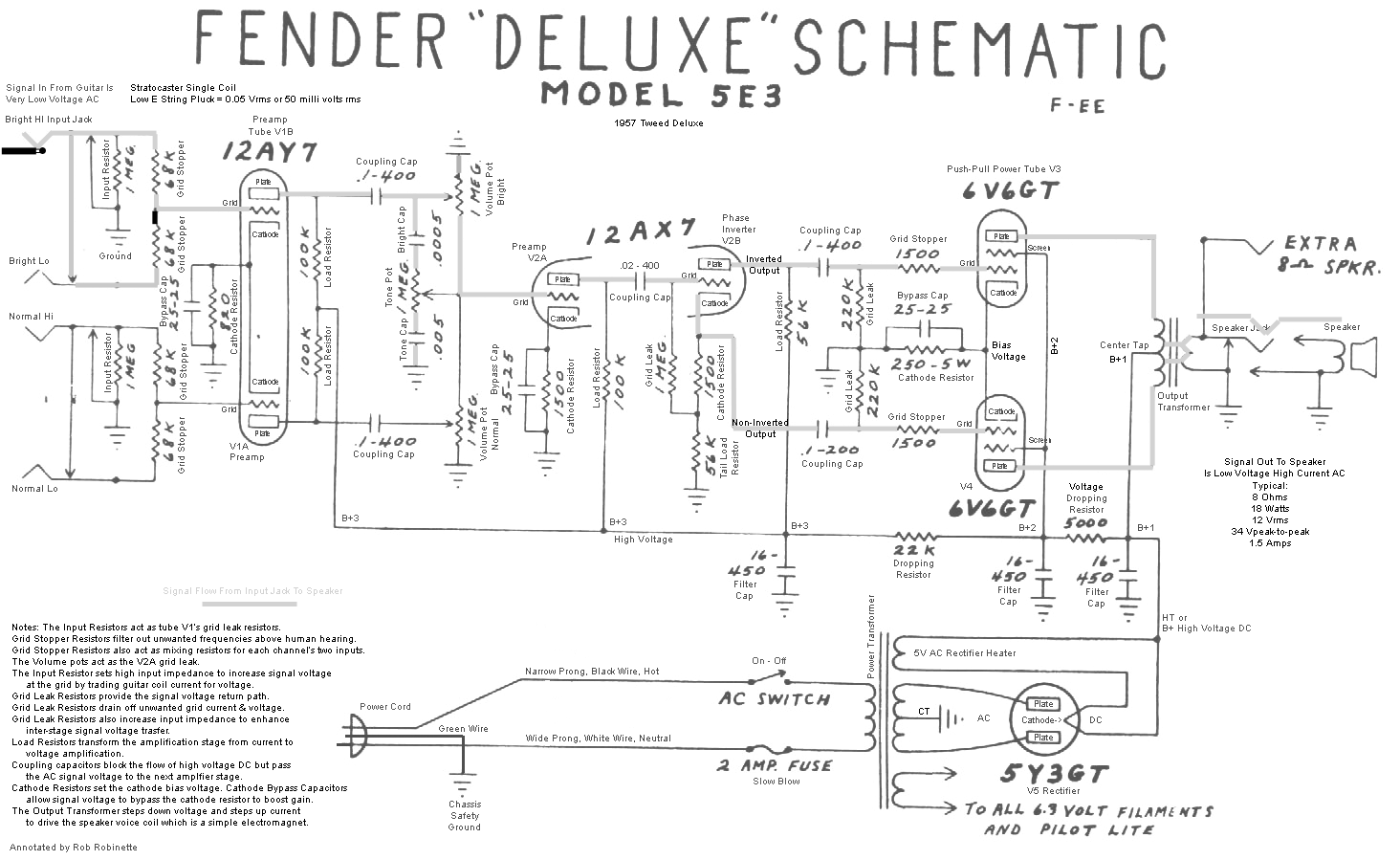
Click the image to view the full size (readable) annotated schematic. A pdf version is here.
The amp's bespeak menses in the schematic above is shown by the thick gray line from the input jack at upper left to the speaker at upper right (to see the larger, readable version of a diagram on this page just click on the diagram). The very low level AC signal voltage from the guitar's coils enters the amplifier at upper left through one of the 4 Input Jacks. Typical signal level from the guitar pickup coils is about 0.1 volt Air conditioning rms but can vary greatly due to the number of pickups, their design and of course how and what is played on the guitar. Serenity jazz played on a guitar with a vintage single coil tin can produce signals beneath the single digit millivolt range (0.001v).
The 5E3 has two channels, the Normal and Vivid Channel. The Brilliant Aqueduct is brighter because of the addition of a single component, the Vivid Capacitor or Brite Cap, which allows high frequencies to bypass the Brilliant Volume control at lower book settings. The lower the volume the more than highs are bypassed so the Bright Aqueduct is usually preferred for lower book playing. At max volume the Bright Cap does nix and the Bright and Normal Channels are identical. The original Fender Bright Cap was 500 pF (pico Farads) but modernistic standard cap values have fabricated it user-friendly to utilize an equivalent 470pF instead. Using a larger value Bright Cap volition allow lower frequencies to pass around the Bright Volume control. Using a smaller value Vivid Cap will raise the cutoff frequency then less mids would exist affected. The Fender 5F6A Bassman used a tiny 100pF Bright Cap then only very high freqs were passed around the book command. Many modern guitar amps utilise a mid size 250pF Brilliant Cap.
The 5E3 Deluxe is famous for it's command interaction. Both volume controls and the tone control all interact with ane another even when just one aqueduct is in apply. Irresolute the book level of the unused aqueduct will alter the tone and breakup of the channel in use. Both volume controls change how the tone control functions. When the 5E3'due south Vivid channel volume is turned total down its bright cap is connected direct to ground on i end and connected to the bright end of the tone pot on the other. The bright cap then acts every bit a high freq tone cap that bleeds high freqs to ground. It'due south not a huge effect just the brightest setting on the tone control moves to less than max on the tone dial. This only occurs when the Normal aqueduct is in use, the Bright aqueduct does non suffer from this control quirk. It's another reason (besides the vivid cap) the Bright channel is brighter than the Normal channel.
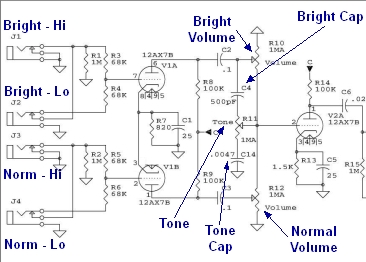
The unused aqueduct volume pot and 100k plate load resistor modify the load on the aqueduct in apply and therefore bear upon the proceeds. The unused channel load can run from 100k at max volume to 1M at min volume. Turning the unused channel volume full downward offers up the about preamp gain.
To get the most out of the 5E3 you must play around with all three controls--especially at high volume levels. This is where much of the 5E3 Palatial'southward magic resides. Hither's an informative quote on setting the controls from clintj, "So, one setting combo that gets me a skilful amount of warm breakdown is this: in-use volume control on 8 or 9, unused volume fix on 4, tone set to at least 9. Arrange your unused book down for more than dirt, up for less, zero should get you in Neil Young territory ."
Each channel has two input jacks, a Hi and Lo. The Lo jacks' inputs run through a voltage divider formed by the two 68K Grid Stopper resistors which cuts the guitar signal in one-half (-6dB). If y'all observe that you prefer the Lo input jacks you lot should consider using the Hi jacks and only turn down the book on your guitar which gives you the same signal level but yous'll have command at the guitar. You should also endeavor "jumpering" the channels together. Plug a short cablevision into ii jacks in the normal and brilliant channels for a thicker tone that's paralleled through both channel'south preamps (example: guitar is plugged into Bright Hi jack then jumper from the Bright Lo jack to the Normal Hi jack). For the graduate level explanation of how the jacks work and how jumpering the two channels together works see this.
Jumpering Channels
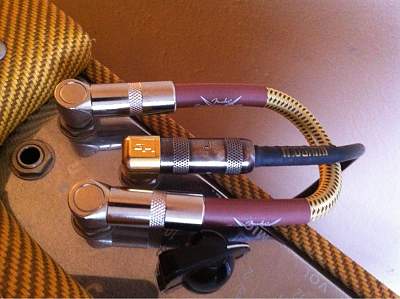
Bright - Hi input used with 6" patch cable between Bright - Lo and Normal - Howdy. Photo by sookwinder.
Each channel has an Input Resistor on its Hi Input Jack. The Input Resistors set the amp'due south input impedance and they act every bit tube V1'south grid leak resistors. For best signal voltage transfer from guitar to amp you want a low impedance from the guitar and a high impedance for the amp (at least 10 times more impedance for the amp is a guide called "the dominion of 10"). This intentional impedance mismatch trades guitar pickup gyre current for voltage--this is called impedance bridging. 1 megaohm is a standard value for most all guitar amps so there'due south no reason to tweak its value. A higher value would add impedance just too add dissonance. A lower value would decrease noise but reduce the voltage bespeak from the guitar. Some high gain amps use lower value grid leak resistors to intentionally benumb the signal to control gain between amplifier stages.
In the 50's and 60's carbon composition resistors were used and if you desire your amp to expect 'period correct' then use them but metal film resistors are over 10 times quieter than carbon comp so use them if you desire the all-time quality sound and everyman noise. Resistors generate the white noise hiss you hear when the amp is turned up to max with no guitar plugged into the amp. The input and grid stopper resistors are a good identify to use metal film resistors considering their hiss will be amplified by every gain stage.
Grid Stopper resistors assist stabilize the amplifier by removing much of the sound indicate above homo hearing. [Bonus info: The Grid Stoppers also act as 'mixing resistors' to prevent interaction between ii simultaneous Hi and Lo inputs like two guitars or a guitar and microphone] The Howdy input uses both 68k grid stoppers in parallel so the grid stopper resistance is really 34k. Grid terminate resistors on the start amplifier stage do remove some high freqs from the guitar signal so some modern amps use smaller grid stoppers and some amps practice without them altogether. Yous tin apply an alligator clip wire to jumper around the grid stopper resistors to try the amp with lower or no filigree stopper resistance but the deviation is very subtle and merely affects very loftier frequencies only it may add some "sparkle." The optimal location for a grid stopper resistor is on the tube grid (input) pin itself so at that place's no bare wire after information technology to act as a radio antenna to pick up radio frequency interference (RFI).
5E3 Layout with Signal Flow and Annotations
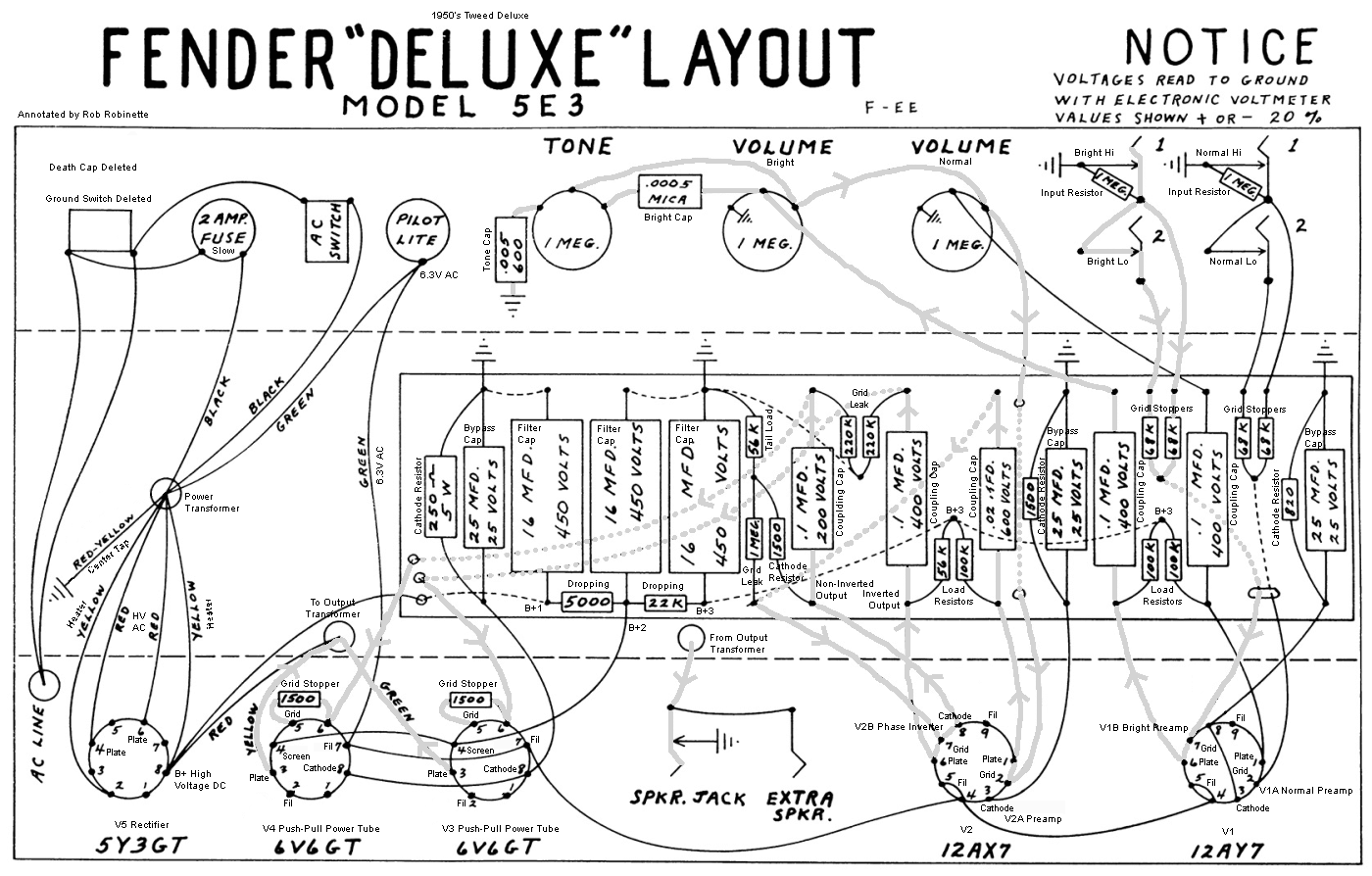
Click the epitome to view the total size (readable) annotated layout. Notice how convoluted the signal path (thick grey lines) is compared to the schematic. A schematic shows electrical flow while a layout diagram shows the physical location of the amp'south components.
Modernistic 5E3 Palatial Layout
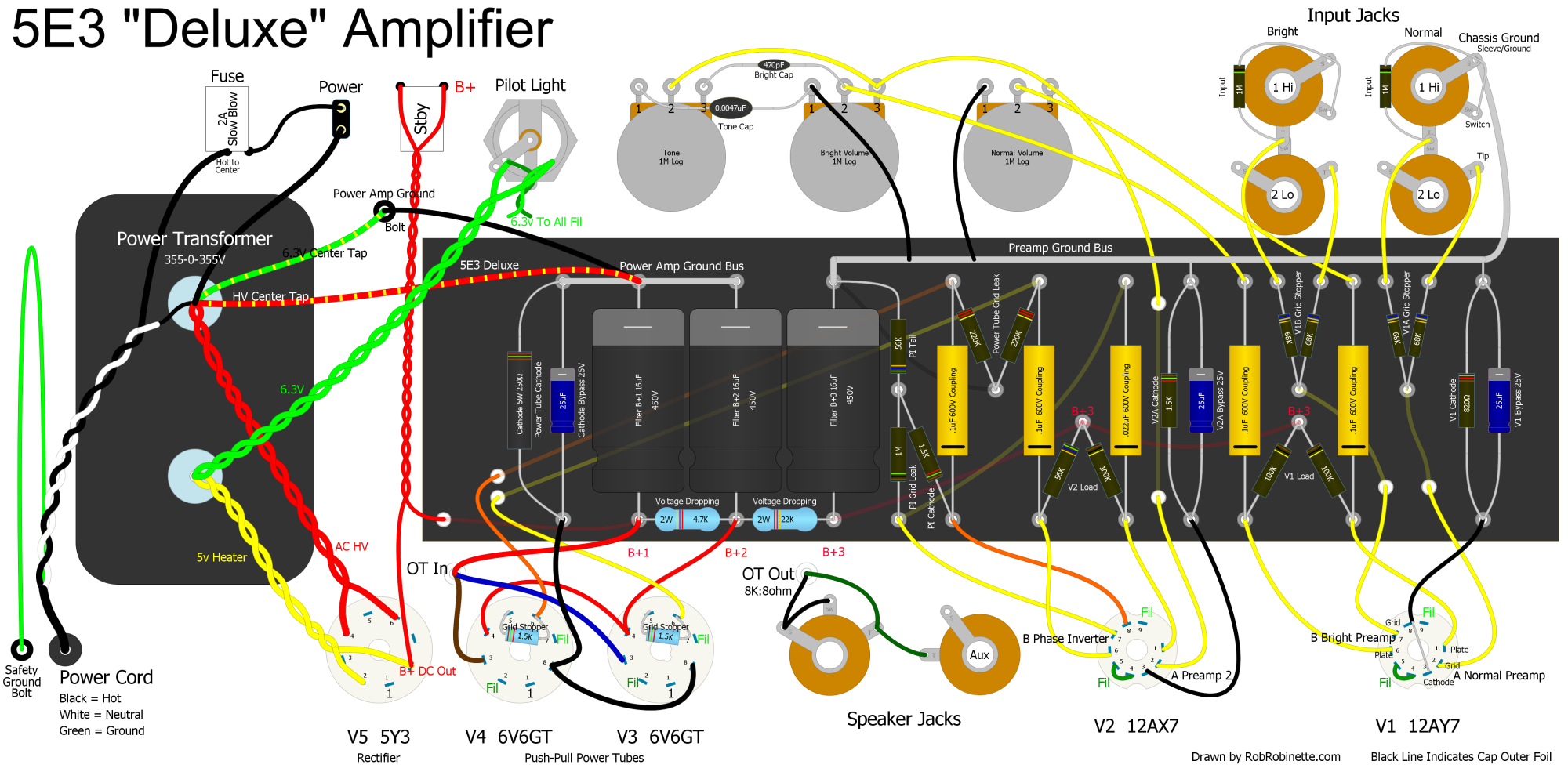
Click the epitome to view the total size layout diagram. Click hither for howdy res pdf. Click hither to download the DIYLC file and so y'all tin can modify this layout diagram yourself.
Layout Diagram Notes:
The Input Resistors act equally tube V1�s grid leak resistors.
The volume pots act as the tube V2A grid leak.
Load Resistors transform the amplification stage from current to voltage amplification.
Coupling capacitors block the flow of loftier voltage DC but pass the AC guitar bespeak voltage to the next amplifier stage.
Cathode Resistors ready the cathode bias voltage.
Cathode Bypass Capacitors allow signal voltage to bypass the cathode resistor to boost gain.
The Output Transformer steps down voltage but steps up electric current to drive the speaker voice roll which is a simple electromagnet.
Later on going through the grid stopper resistors the sound indicate flows down the wire to the preamp tube's pin two (command filigree), which is the entry to the 'A' half of the preamp tube (V1A). It'southward called V1A because tubes were called 'Valves' and this is tube number 1 and we're using half of the tube, the 'A' triode. A triode has iii electrodes, a grid, cathode and plate (anode).
12AY7 is the type of tube and it's really two tubes in one (dual triode). The filigree is the 'control valve' that controls the flow of electrons through the tube. The AC guitar audio indicate charges the filigree positively and negatively as it alternates. A positive grid volition allow electrons to flow from the cathode, through the grid to the plate. A negatively charged filigree will block the flow of electrons through the tube. See How Tubes Work for more info.
Notice that tube V1 has only one cathode resistor valued at 820 ohms. It is shared past both triodes (both halves) of V1 so the cathode resistor is approximately half the value of a cathode resistor used for a unmarried triode such as V2A's 1.5k cathode resistor. Two triode circuits sharing one cathode resistor will pull twice the electric current through it so yous have to cutting the resistance in half to become the aforementioned voltage driblet across the resistor. The voltage drop across the cathode resistor puts the cathode at a positive voltage compared to the control filigree (normally around +1.vii volts DC). This voltage difference is the triode'due south bias. Some mod loftier gain amps bias their preamp triodes cooler using a 2.7k cathode resistor or bias it hotter with an 820 ohm resistor. Both volition reduce headroom and boost preamp distortion. Increasing the cathode resistor value also reduces gain and decreasing it will boost proceeds.
The hottest bias for a preamp gain stage I take ever seen in a commercial amp is an 820 ohm cathode resistor (not shared). The coldest bias I accept seen is a 39k cathode resistor in a Soldano loftier proceeds amp. The very high value cathode resistor is designed for early clipping to intentionally generate preamp distortion. This type of preamp phase is called a Cold Clipper and was commencement used in the Marshall 2204 amplifier.
The 5E3 uses a 12AY7 preamp tube for the first gain stage. Y'all can substitute a higher gain 12AX7 to boost distension, reduce headroom and increment breakup and distortion. The preamp tube amplifies the guitar audio signal then sends it out pin 1 (plate) to a coupling capacitor or 'cap.' Coupling caps are sometimes called 'blocking caps' because they block DC (direct current) voltage. DC flows in only one management where AC (alternating current) alternates its direction of flow--the electrons really change management and movement back and along through a circuit.
Loftier voltage DC power used by the tube is brought in through the load resistor. Load resistors change the distension stage from a electric current amplifier to a voltage amplifier. Many modern amps have load resistor bypass capacitors to remove frequencies in a higher place human hearing to stabilize the amplifier and foreclose oscillation in high gain amps. You can also remove "ice selection highs" with a load resistor bypass cap.
The wire between tube pin one (plate) and the load resistor carries up to 250 volts DC. This wire carries the AC audio bespeak out while simultaneously bringing in the high voltage DC ability the tube needs to office. Coupling capacitors allow the AC sound signal to laissez passer through but block the high voltage DC and keep information technology from flowing into the post-obit amp phase.
How capacitors block DC merely let Air-conditioning pass: Caps are actually made with sandwiched conductive plates but I like to visualize them equally having a stretchable rubber membrane inside that blocks the flow of electricity. When voltage is applied to a capacitor the 'rubber membrane' stretches and bulges every bit electrons try to flow through it. The higher the voltage the more the membrane bulges. If y'all apace reverse the capacitor's voltage polarity it will go from jutting ane way to bulging the other style. This is what a pocket-sized AC signal does--information technology stretches the 'membrane' back and forth equally the voltage alternates which allows electrons on both sides of the capacitor to movement back and forth (alternate) but a constant DC voltage that is trying to period in one direction will be blocked by the membrane.
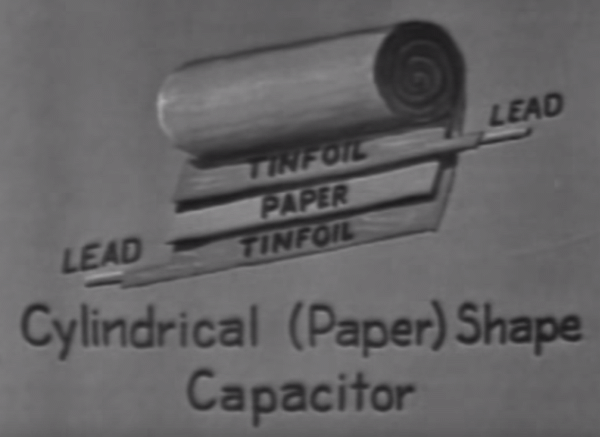
Capacitors are made of 2 conductive plates separated by an insulator or dielectric. Mutual dielectrics are mica, polypropylene, ceramic, paper and even oil.
The Fender 5E3 Palatial uses very large value .1uF (micro Farads) coupling capacitors which allow low frequencies to flow through the amp. These depression frequencies employ a lot of power and cause the 5E3's infamous "loose low end" and tin can pb to severe blocking distortion known every bit "farting out." Reducing the value of the coupling caps volition filter out some lows and tighten up the amp and make the amp more than humbucker pickup friendly. The overdrive tone will as well tighten up. Modern, high proceeds amps use extremely small coupling caps (0.0022uF) to reduce bias drift, blocking baloney and go on the overdrive tone tight. Run across my Tube Amp Overdrive page for more info. Some people lower the value of the 5E3 coupling cap in only 1 aqueduct and go out the other aqueduct lone so you lot tin choose between standard Deluxe or a tighter, more modern tone (see the Vox a Lead Channel modern). Smaller coupling caps can likewise better the mode the 5E3 works with FX pedals, especially gain boost, delay and reverb pedals.
Another mode to trim the 5E3's low end 'fatty' and tighten up the amp is to reduce tube V1's or V2A'due south cathode bypass capacitor. Both take a 25uF 25v cap that is big enough to boost all guitar frequencies only many modernistic amps use a bypass cap as depression equally .68uF (680 nano Farads) to boost only mid and high freqs. If yous wanted to alter just one of the 5E3's channels y'all'd have to separate the V1A and V1B cathodes by adding some other cathode resistor and bypass cap (see the Voice a Lead Channel mod).
After the coupling cap the guitar sound signal flows to the volume and tone potentiometers (pots). The book pot acts as a variable voltage divider which when turned down will attenuate the indicate voltage. Volume knob left = less voltage signal and lower book. Volume knob right = more voltage signal and higher volume. Changing the volume pots from i one thousand thousand to 500k (i million ohms to 500,000 ohms) will transport more than point to footing and attenuate the betoken path. [Bonus info: The volume pots too function as V2A's grid stopper and grid leak resistors]
The tone pot in combination with the tone capacitor create a variable RC (resistance capacitance) low pass filter which removes loftier frequencies by shunting them to basis. Using a college value tone cap will lower the cutoff frequency of the tone control so it will affect more mid frequencies. Reducing it will raise the cutoff frequency and bear on less mid freqs.
The guitar signal next flows to tube V2A'due south pin vii (grid). This phase acts every bit the 2nd gain stage which boosts the guitar signal voltage. The audio bespeak leaves tube V2A via pin six (plate) and flows to another coupling cap that blocks DC. The signal and so flows to V2B, the cathodyne stage inverter where the guitar signal is split up into two streams for the ii power tubes. The betoken enters at V2B's grid and flows out its plate to a coupling cap and on to ability tube V3'south grid. This betoken is inverted compared to the phase inverter input. The signal also flows out V2B's cathode to a coupling cap and on to ability tube V4'due south grid. This point is non inverted and so the ii signals flowing to the power tubes are 180 degrees out of phase--mirror images of one some other--i is inverted and one isn't. Unlike the 5F6A Bassman's long tail pair phase inverter, the 5E3'due south cathodyne phase inverter barely amplifies the guitar point. Information technology's differential proceeds gene is e'er slightly lower than 2. If you upgrade the 5E3 to run big 6L6 ability tubes the cathodyne stage inverter won't be able to drive them to full baloney the mode a long tail pair phase inverter tin.
After the phase inverter the guitar signal flows through some other coupling cap to cake loftier voltage then to the power tube grid stopper resistors. Similar the preamp grid stopper resistors they help filter out noise above man hearing to prevent oscillation only they as well perform some other of import function, they help control blocking distortion to continue the overdrive tone sweet even when pushed very hard. Similar all grid leak resistors you can employ the power tube filigree leak resistors value to control the input signal voltage. A larger value grid leak will cause less indicate attenuation and a smaller value volition increment attenuation. Typical ability tube grid leak values are 100k and 220k.
The power tubes, V3 and V4, are sometimes referred to as the output tubes. While the preamp tubes accept iii electrodes: Cathode, control grid and plate (a tube with 3 electrodes is called a triode) the power tubes are pentodes with five electrodes: Cathode, control grid (g1), screen filigree (g2), suppressor filigree or beam forming plates (g3) and plate. The screen grid is held at a constant, high positive voltage to assist pull free electrons from the cathode, through the control grid to the plate. The suppressor grid helps prevent electrons from bouncing off the plate. Information technology is tied directly to the cathode.
Although the 5E3 doesn't have them, screen filigree resistors are used in most amps to prevent tube harm from excessive screen filigree current. These resistors are normally between 470 to 1500 ohms and rated for three or 5 watts of estrus dissipation. The 6V6GT is a beam pentode and therefore flows trivial screen current so the 5E3 can get abroad with running without screen grid resistors. But if you lot want to run non-beam, true pentodes like the EL34 so y'all should install 1k five watt screen resistors. Screen grid resistors will also increase the screen voltage drop when screen current flows which will increase the amount of power tube baloney caused by screen voltage drop. Adding a 470 ohm iii watt resistor to the 5E3 can add sweet sounding power tube baloney then it is a modification to consider.
The power tubes are the final stage of amplification. Where the preamp tubes are voltage amplifiers, V3 and V4 are power amplifiers (power = voltage ten current) and their output is expressed as watts. The guitar betoken enters at pin five (control grid) and leaves via pin 3 (plate) and flows through the output transformer (OT).
The output transformer's primary and secondary windings are really just 2 wire coils wrapped effectually an atomic number 26 core. The input, or principal coil winding uses electric current flowing through the coil to generate a magnetic field or flux. This magnetic field fluctuates with the Air-conditioning signal voltage. The magnetic flux flows effectually the transformer fe core to the secondary curlicue which generates a voltage in the secondary gyre winding. You can modify the voltage and current from primary to secondary past changing the ratio of coil wraps from primary ringlet to secondary.
Transformers
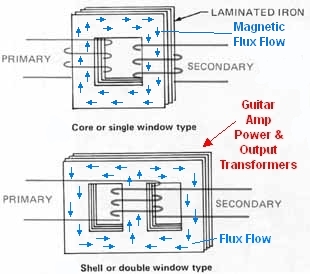
Current flowing into the primary winding induces magnetic flux catamenia effectually the transformer core which in plow induces an electric current in the secondary winding. Put fewer wire wraps on the secondary (output) winding and its voltage will decrease (footstep downwardly) merely its electric current will increment. Most guitar amp transformers are of the 'beat' type (lesser of diagram) and fabricated with laminated atomic number 26 magnetic cores.
Example: The principal winding has 200 wraps of wire in its coil and the secondary has 100 wraps. If a 10 volt one amp alternating current is applied to the primary winding the secondary will generate 1/2 of the voltage simply twice the current so five volts and 2 amps would be put out by the secondary winding. This is what an amplifier's output transformer does, it steps down the signal'southward voltage but steps up the current because the speaker's voice curlicue needs electric current to move the speaker cone.
At high volume the 5E3's output transformer reaches saturation which tends to compress the signal. In one case saturated an output transformer tin't flow any more flux or go any louder so loud notes are capped just softer notes are yet amplified so at that place'southward less volume difference between loud and soft guitar notes. Upgrading the 5E3 to a larger, higher watt rated output transformer will boost maximum book and reduce compression (the output volition exist more than dynamic, accurate and solid state sounding)--but some of the Deluxe'south magic lies in its high volume compression.
The output transformer'south principal takes in a high voltage, low current point (high impedance) and puts out a low voltage, high current point (low impedance). Typically most 320 volts of swing from the power tube plates flow into the output transformer primary and well-nigh 12 volts AC flows out the secondary through the blueish wire to the speaker jack and on to the speaker.
The speaker jack has a congenital in switch that grounds the output transformer's secondary when no speaker is plugged in. Information technology does this because if you power upwards the amp with no speaker connected the output transformer will generate very high voltage in the secondary winding and fry itself if it sees an open excursion. The basis switch on the jack gives the transformer secondary a closed, short circuit which it can handle much meliorate than an open up circuit. Always have a speaker connected to a tube amp when you ability it upward. The aux jack is tied direct to the main speaker jack's tip and ground. Because of the principal jack'due south ground switch you must have a speaker plugged into the primary jack for the aux jack to function. You should utilize an 8 ohm aux speaker forth with the cab speaker which will give the amp a four ohm load which Fender considers safe for the amp. A 4 ohm aux speaker will give the amp a too low load which will reduce output and stress the ability tubes.
From the speaker jack the signal moves on to the speaker. The alternate current sound signal flows through the speaker'due south voice coil which generates a magnetic field. The vocalisation coil is simply a single wire wrapped into a coil as shown below. The magnetic field created by the voice coil is either attracted to or repelled by the speaker's magnet. Positive voltage in the vox curl generates a repulsive magnetic force and the speaker coil and cone moves outward away from the speaker magnet. Negative voltage generates an attractive magnetic strength and pulls the speaker cone inward. The speaker cone alternates between moving outward and inward as the guitar bespeak voltage alternates betwixt positive and negative.
Speaker Voice Curl is an Electromagnet
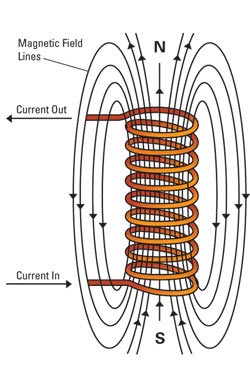
Electric current flowing through the speaker's voice coil generates a magnetic field. When the audio point electric electric current reverses the magnetic field also reverses causing attraction and repulsion to the speaker magnet.
This in and out movement of the voice coil and speaker cone creates air pressure level waves that our ears perceive as audio--the sweet sound of electric guitar. For every motility of a guitar string the amplifier generates a corresponding motility of the speaker cone. When the speaker cone moves outward a positive air pressure moving ridge is created and when the cone moves inwards a negative (depression force per unit area) moving ridge trough is generated. These air pressure waves move our ear drums in and out. The ear drum motion is translated into neuron activity which is sent to the brain where pleasance is created, thus electrical guitar + amp = pleasure.
Speaker

The 'vocalism coil' is an electromagnet that interacts with the speaker magnet. The 'spider' supports the vox curlicue but allows it to move in and out freely.
So the main purpose of the 5E3 guitar amplifier is to take the tiny electrical signal generated by the guitar's pickup and brand information technology strong enough to push and pull a speaker cone. The guitar amp is besides used to shape the tone and control baloney giving usa the clean, mellow sound of jazz guitar or the brute growl of hard rock. Distortion is an important part of guitar amplifier design and this is the principal difference between guitar and sound amplifiers. Sound amps are usually designed for absolute minimum baloney. See Tube Guitar Amplifier Overdrive for specific information on how overdrive distortion is created.
5E3 V2A Load Line Nautical chart
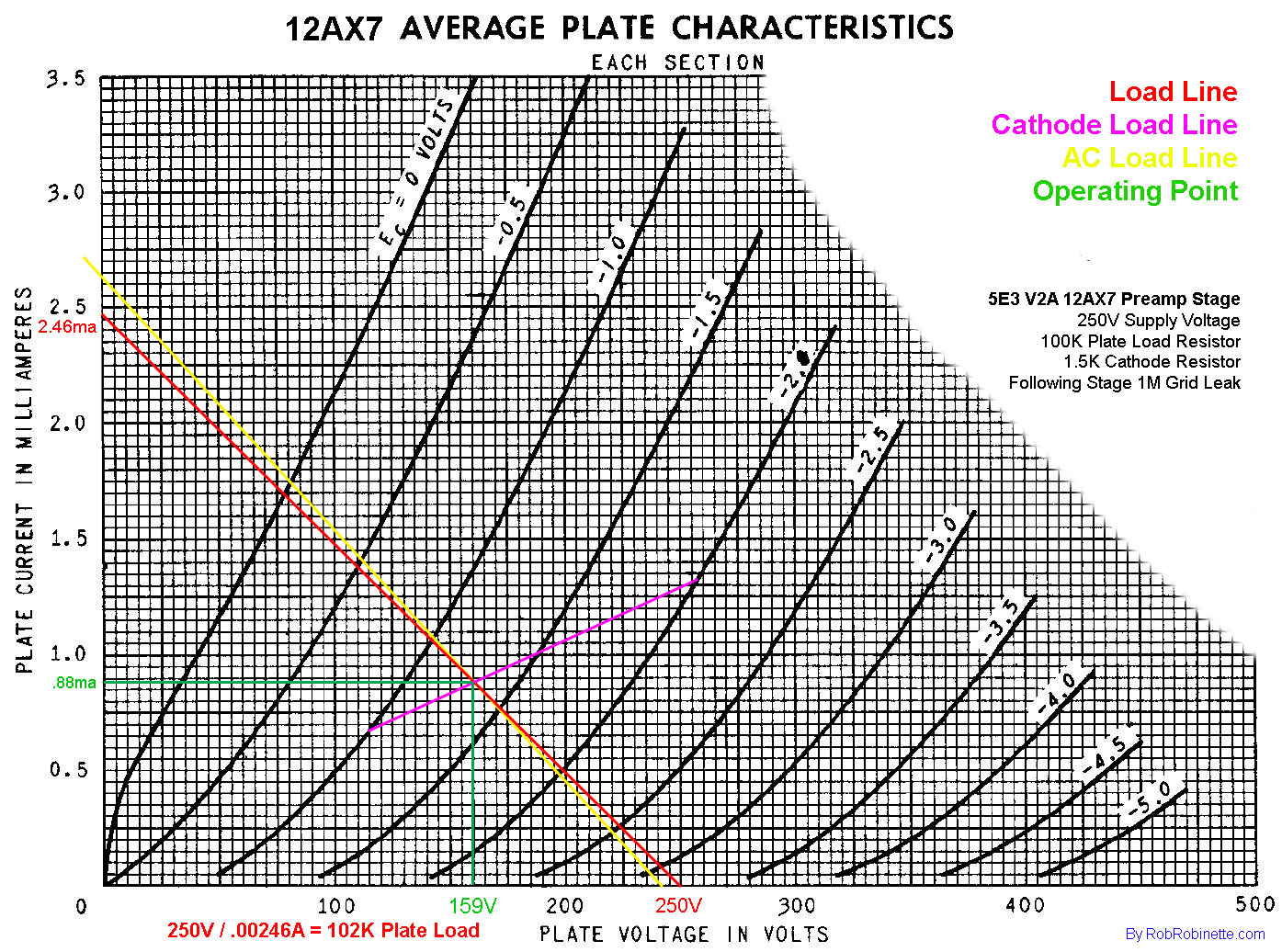
The 5E3's V2A is a very generic gain phase with a nice center bias for maximum headroom and symmetric clipping. Note the color coded legend at upper right. Load line in red, cathode load line in magenta, AC load line in yellow and operating point (bias bespeak) in green. For information on how these lines were charted meet How to Depict Load Lines.
Power Supply
Now that we've covered the signal flow I'll go back and cover the other amplifier components that I didn't mention. Wall plug ability of 120 volts Air conditioning (or 100, 220 or 240 volts AC in other countries) runs through the fuse and on to the power switch. The fuse is a two amp slow blow fuse. Irksome blow ways it won't accident instantaneously when the turn-on power surge runs through it. Sustained electric current greater than 2 amps is required to blow the fuse.
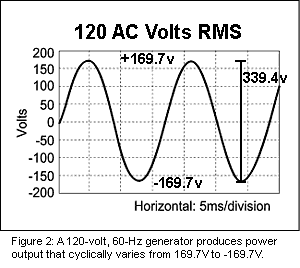
120 Ac volts RMS (DC equivalent average) wall power equals 339.4 volts pinnacle-to-summit.
After the amp's fuse and On/Off switch the 120v Ac runs to the power transformer (PT), through its chief winding, then back to the wall plug via the white neutral wire*. The power transformer has three secondary windings. The first winding steps the 120v AC upward to 650 volts Ac. Two other small secondary windings stride the 120v AC downwards to six.three volts Ac and v volts AC (notice all voltages output by transformers are ever Air conditioning). The 6.3 volts is used to power the pilot light and rut the preamp and power tubes' heater filaments which oestrus the tubes' cathodes. The 5 volts is used to heat the rectifier tube'southward cathode.
* Bonus Info: When I first learned that the power transformer chief coil was made up of one long wire that directly connects the 120v hot wire to the neutral (footing) wire I wondered why it didn't short out. The reason is the principal and secondary coils are coupled together by the transformer'south fe core. Alternating current in the principal curlicue creates a magnetic field or flux that is captured past the core. That flux flowing around the core creates an AC voltage in the secondary coil. The load (impedance) placed on the secondary winding by the amplifier is transferred through the core to the primary whorl. That impedance keeps the primary ringlet from "shorting out."
The 650 volts Ac power from the power transformer is fed directly into V5, the 5Y3 rectifier tube. V5 is a full wave dual plate rectifier tube that converts alternating current (Air-conditioning) into direct current (DC), which the amplifier's electronics actually need to part. The power transformer and rectifier tube have internal resistance that cause voltage sag when higher electric current is demanded. Installing a higher rated power transformer can reduce voltage sag and "stiffen" the amp'due south tone, make it sound "punchier" and aid tighten the bottom end.
370 volts of DC flows out of the rectifier tube'due south pin 8 (cathode) and is referred to as B+ or B+one voltage (from one-time Bombardment Positive designation). Yous can raise the DC voltages in the amp by swapping out the 5Y3 rectifier tube for a higher output tube simply be conscientious because your 6V6 power tubes can be damaged by too loftier a plate voltage. College amp voltage tends to increase output ability, tighten up the tone and make information technology "punchier."
The B+1 DC voltage flows to the output transformer'due south main winding and to the circuit board'southward three large filter/reservoir capacitors and two voltage dropping resistors. These resistors and capacitors form RC (resistance capacitance) low laissez passer filters that take the lumpy, pulsing DC output of the rectifier tube and smooth information technology out--the smoother the improve. Any waves or ripples left over in the DC power would be added to our audio signal and heard as 120Hz hum in the preamp and power tubes. The filter caps also act as a power reservoir so the larger the value of the capacitors the "stiffer" the amp sounds because the amp can react to power demands with less voltage sag. Depression frequencies need more power then larger capacitors can really help the low end and prevent "farting out."
Notice the resistors between the filter caps. These are voltage dropping or stride down resistors that reduce the 370 volts DC B+1 down to 295 volts DC B+2 then to 250 volts DC B+three. The B+ane voltage from the rectifier is tapped off to feed directly to the output transformer'southward primary center tap which feeds the power tubes' plates. The 295 volts DC B+two is connected to the ability tubes' pins 4--the screen grids. The 250 volts DC B+3 is used to ability the preamp and phase inverter tubes but it'south stepped down even more than by their load resistors. The filter capacitors and voltage dropping resistors also decouple the three B+ ability nodes to prevent interaction, feedback and oscillations betwixt the preamp and ability tube. Y'all can raise or lower the B+2 and B+3 voltages by adjusting the value of the voltage dropping resistors.
Now that you know how the 5E3 works let's talk about modifying it.
5E3 Power Transformer Calculations
The following equations and calculations estimate the maximum ability use of the 5E3.
5V Rectifier Heater Electric current
The 5E3 Deluxe'due south 5Y3 rectifier uses ii amps of 5V heater current. Other rectifiers: GZ34 uses 1.nine amps and the 5U4 uses 3 amps.
half-dozen.3V Heater Electric current Calculations
Heater electric current in amps: Preamp tubes: 0.3, KT88/6550: i.half dozen , KT66: 1.iii , EL34/6CA7: 1.5 , 6V6: 0 .45 , EL84/6BQ5: 0 .8 , 6L6: 0 .nine , 5881: 0 .ix
Calculated six.3V filament current: (2 * 6V6) + (two * preamp tubes) = (2 * 0.45) + (2 * 0.iii) =1.5A
B+ Current Calculations
B+ current is supplied by the ability transformer'southward loftier voltage secondary. Preamp tube current is and then low information technology isn't necessary to actually calculate the value so nosotros can but estimate information technology at 3ma per triode (two triodes per preamp tube).
Ability Tube B+ Current Calculations:
Transformer voltage: 355-0-355 volts Air-conditioning RMS. The 0 means the transformer has a grounded 0 volt centre tap and the transformer puts out +355v on one wire while simultaneously putting out -355v on the other for a 710v AC RMS voltage wire-to-wire.
Max_Plate_D issipation in watts from tube information sheets: KT88/6550: 42 , KT66: 25 , EL34/6CA7: 25 , 6V6: 12 , EL84/6BQ5: 12 , 6L6GC: 30 , 6L6WGB/5881: 23 , 6L6/G/GA/GB/WGA/5932: 19, Preamp tubes using both triodes every bit power tubes: 12AX7: ii, 12AT7: 5, 12AU7: 5.v, 12BH7A: seven
Rectifier_Efficiency: Solid country total wave diode: i.37 , GZ34: 1.36 , EZ81: 1.30 , 5U4B: 1.28 , 5Y3: 1.25
Unloaded_B+ voltage = Transformer AC * Rectifier_Efficiency = 355V * 1.25 = 443.8V. This would be the B+ voltage with no preamp or power tubes installed.
B+_Voltage_Drop under load is estimated at sixteen% = 443.eight * .16 = 71V
How far the B+ drops is dependant upon the output transformer'southward current rating. A transformer operating near its max current rating can't refill the filter (reservoir) capacitors as quickly every bit a larger, college rated transformer so the voltage will driblet more.
B+ Voltage = Unloaded_B+ - B+_Voltage_Drop = 443.8 - 71V = 373V
Calculated_Ideal_Load = B+^two / Max_Plate_Dissipation = 373V^ii / 12w = 11,594 ohms
Notes: Calculated_Ideal_Load is the ideal plate-to-plate impedance of the output transformer. ^two means squared.
Load = eight,000 The 5E3 standard output transformer is 8,000 ohm primary : 8 ohm secondary
Power_Tube_Power = (Number_Power_ Tubes * (B+ � 30)^2) / Load
= (2 * (373V � 30V)^2 / 8,000 ohms = 29.4 watts
Note: Power Tube power use, not power to the speakers. B+ is the max plate voltage and 30V is the minimum plate voltage.
Power_Tube_Current = Power_Tube_Power / B+ = 29.4W / 373V = 78.8 milliamps
Calculated_HT_Current = Power_Tube_Current + Preamp_Tube_Current
= (78.8ma + (3ma * iv) ) = xc.8 milliamps
So a 5E3 ability transformer must supply at least 2 amps of 5V rectifier heater current, ane.five amps of half-dozen.3V electric current for the tube heaters and 90.eight milliamps (0.0932 amps) of B+ current. It uses 10 watts of 5V, 9.five watts of 6.3V and 34 watts of B+ for a full of 53.6 watts, less than a threescore watt light seedling.
See my Amplifier Power Transformer Calculations spreadsheet to automate these calculations.
Standard 5E3 DC Voltages
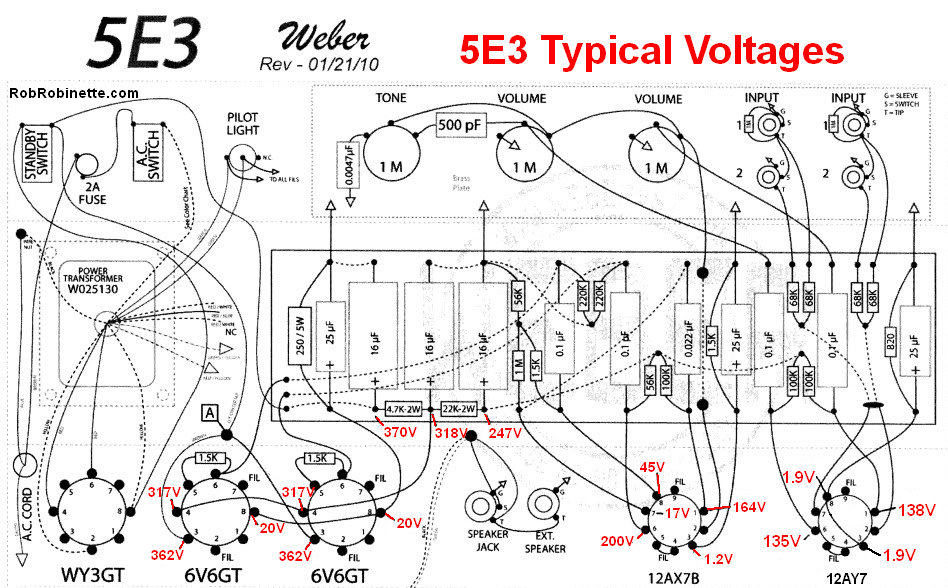
Voltages shown in crimson are DC.
Typical 5E3 B+ Idle Currents
V1A 1.1ma = 110v drop beyond 100k plate load resistor = 110v / 100k
V1B ane.1ma = 110v drop across 100k plate load resistor = 110v / 100k
V2A .83ma = 83v drop beyond 100k plate load resistor = 83v / 100k
V2B .84ma = 47v drop beyond 56k plate load resistor = 47v / 56k
V3 38ma = 19v drop across 250 ohm cathode resistor / ii = 19v / 250 / ii
V4 38ma = 19v driblet beyond 250 ohm cathode resistor / ii = 19v / 250 / 2
Full: 79.9 milliamps
My suggested layouts for a new build 5E3
Classic 5E3 Layout

Notation the Weber split up ground omnibus, power amp ground on left, preamp basis bus on right.
Optimized 5E3 Layout
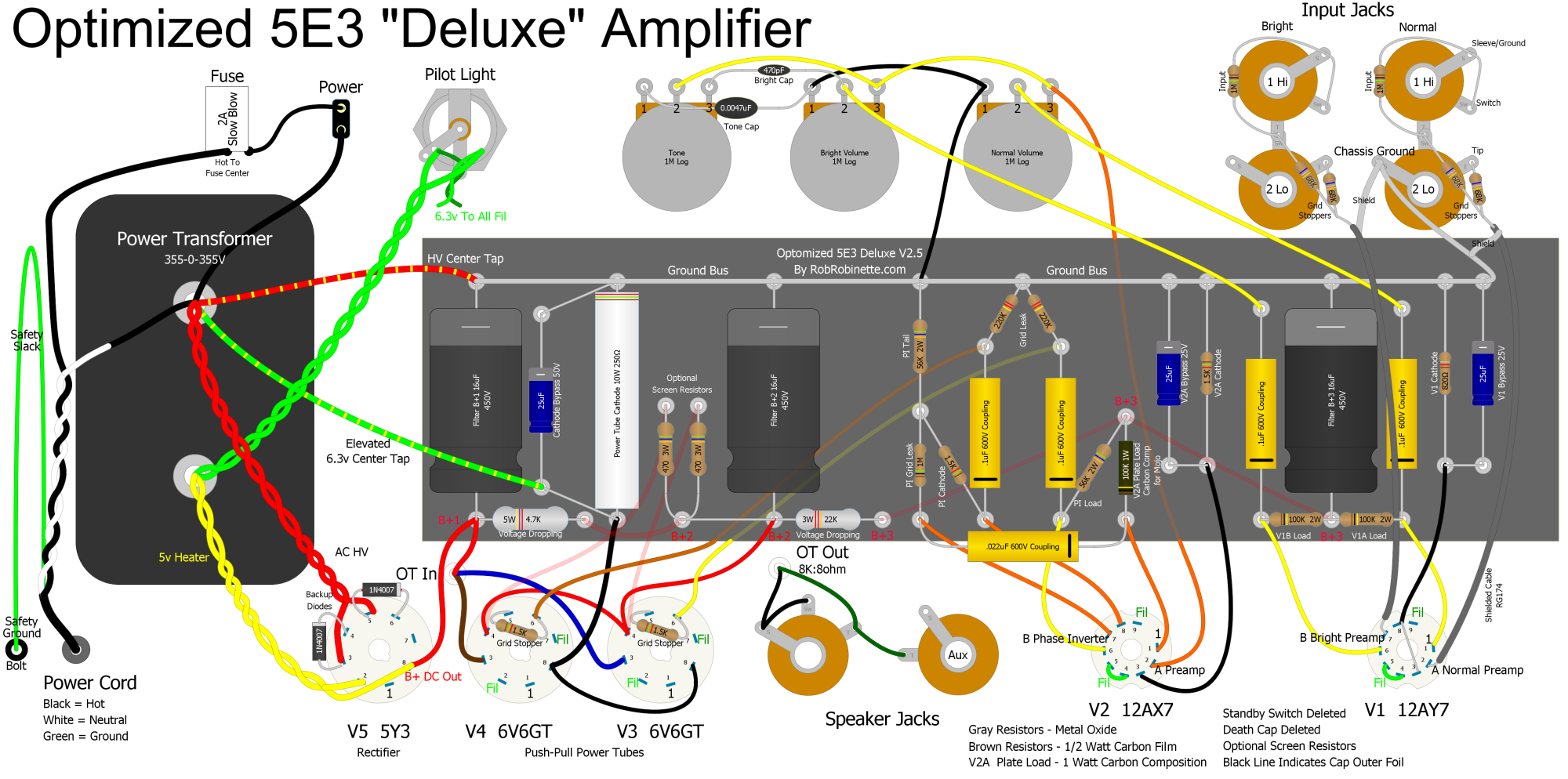
Click on the layout to see the full size image. The pdf is hither. Upload the optimized Hoffman excursion board file to the HoffmanAmps.com DIYLC file analyzer to have an eyelet or turret board built for about $20.
This is my take on the best possible layout for a standard 5E3 chassis. This is a bones 5E3 circuit, there are no modifications that will affect the tone. I have deleted the totally unnecessary Standby Switch and Death Cap.
Shielded cable is used to connect the filigree stoppers directly (across the chassis) to V1. The cable shield is grounded to an input jack ground tab. The V1 end of the cable is not grounded to foreclose a ground loop. A dainty, make clean option is to use shielded microphone cablevision which has 4 conductors and run both input wires through i microphone cable. Shielded cable isn't a necessity in the 5E3 merely if you utilize standard wire I recommend you run information technology along the chassis floor and below the circuit board to allow the chassis act every bit a noise shield.
Separate eyelets are provided for the preamp tube cathode resistors and bypass caps. The B+iii filter cap is moved to supply V1 directly. The V2A coupling cap is reoriented to reduce cablevision runs. Wire routing is optimized for shorter runs, ninety caste wire crossings and maximum separation between grid and plate wires.
The choice of resistor is upward to you but I recommend ane watt metal picture show everywhere except where noted on the layout. Metal film resistors generate one/tenth the resistor hiss compared to carbon composition resistors but I did follow R.G. Nifty's suggestion to use ane or .5 watt carbon comp resistors on just the stage inverter load and tail resistors for a picayune carbon mojo. A 10 watt 250 ohm cement resistor is used for the power tube cathode. The plate load resistors are bumped up to 2 watts and the voltage dropping resistors are upgraded to three and 5 watts for component longevity.
I employed a unified basis bus that is only grounded at the Normal Depression input jack. The power transformer high voltage eye tap is continued directly to the B+1 filter capacitor negative terminal to minimize hum. The typical split-bus ground sends all the preamp return current through the chassis. This ground scheme doesn't flow any electric current through the chassis which any electrical engineer volition tell you is a expert matter.
The half-dozen.3v center tap is connected to the tube side of the power tube cathode resistor to drag the reference voltage to reduce hum. If you want to utilise an artificial 6.3v center tap then I recommend putting the 100 ohm resistors on the V3 power tube socket like this.
I also shortened up the component span to keep from stretching the small component leads so much.
I added optional ability tube screen resistors to the circuit lath. They are shown "ghosted" on the circuit lath between the power tube cathode resistor and the B+ii filter cap. I add them to all my 5E3 builds because they help protect the tubes during heavy overdrive and they sweeten the power tube distortion. If y'all exercise desire to apply them and so do not use the red wire that runs from the B+2 cap to the power tube pins 4, use the wires from the acme of the screen resistors to pins iv instead.
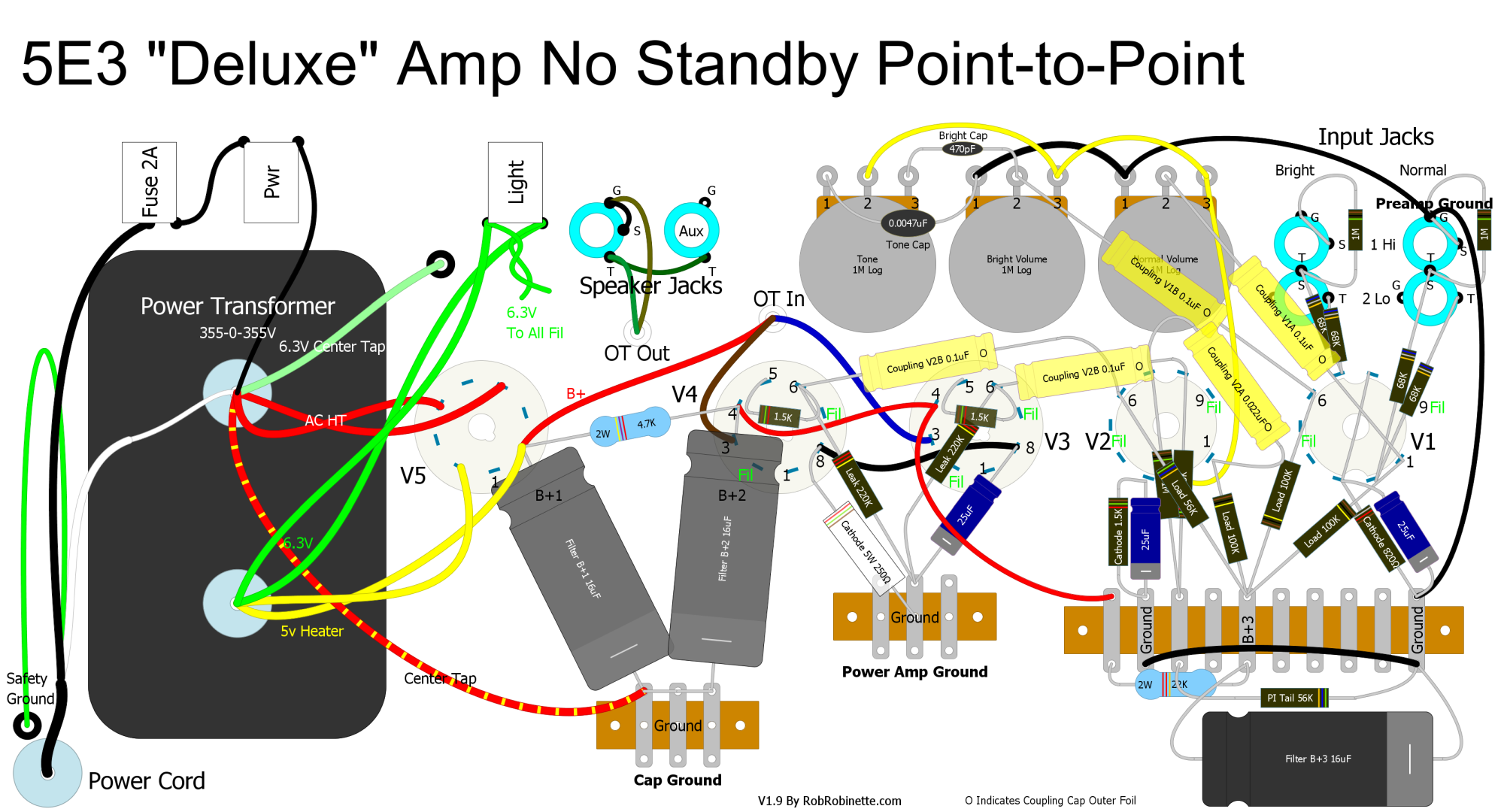
The worthless standby switch has been removed which immune some simplification and optimization of this point-to-signal layout. I used a elementary 3-point grounding scheme with the start ii filter caps' basis isolated. The "Cap Basis" and "Power Amp Ground" tag strips are grounded to the chassis. The preamp ground at lower right is grounded through the black wire continued to the Normal Hi input jack at upper right--the tag strip'due south eye basis final is not used.
VHT Standard 12 Version of the 5E3 Deluxe
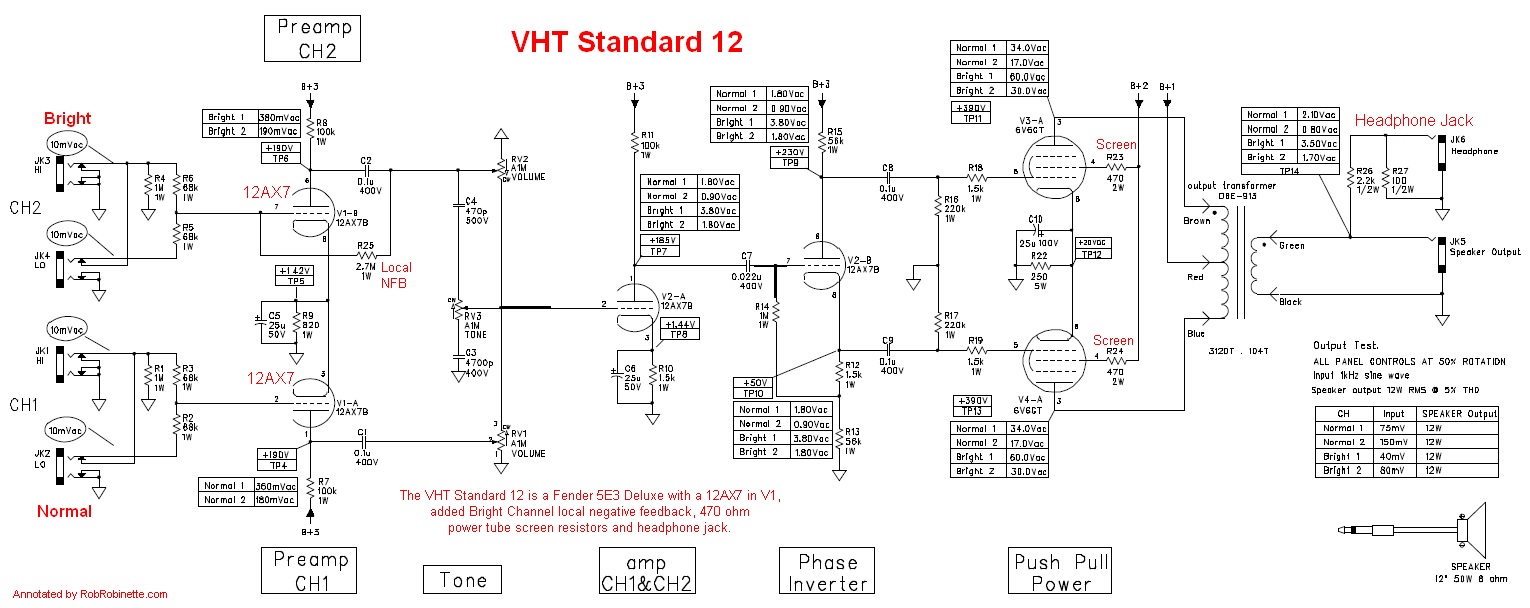
The VHT Standard 12 is a 5E3 Deluxe with a 12AX7 in V1, added V1B Brilliant Aqueduct local negative feedback (Local NFB center left), 470 ohm power tube screen resistors and headphone jack (upper right).
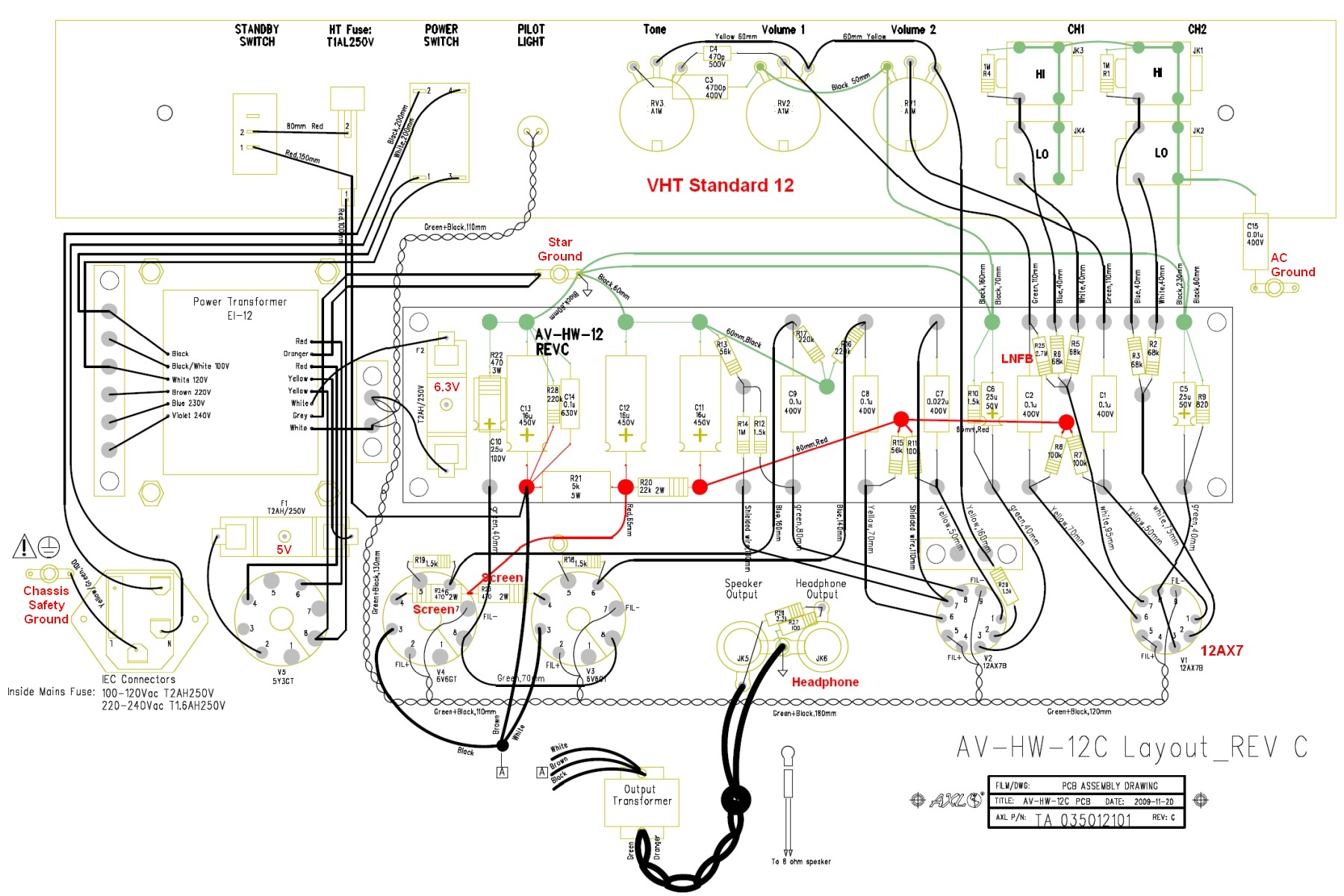
2.7M Local Negative Feedback (LNFB at center right), 470 ohm 2 watt screen resistors on the power tube sockets and added headphone jack circuit (center low). Green wires are basis connections.
The addition of the V1B local negative feedback circuit volition slightly reduce Bright Channel gain and distortion and help tame the extra gain from the 12AX7 in V1 (5E3 uses a 12AY7 in V1). Adding 470 ohm power tube screen resistors would sweeten ability tube distortion and aid protect the tube from screen failure during heavy overdrive. The amp uses a star grounding scheme with isolated Cliff input jacks connected to an AC only ground through capacitor C15. The headphone circuit's 2.2k and 100 ohm resistors form a voltage divider which cuts the amp's output to the headphone by 96%. The headphone output suffers from the lack of speaker tone shaping and breakdown. I recommend anyone owning a Standard 12 endeavour a 12AY7 in V1 for a more authentic 5E3 tone.
Original 5E3 Deluxe Photos
These pics are from a nigh virgin 5E3. All photos in this section were generously donated by Keithb7.
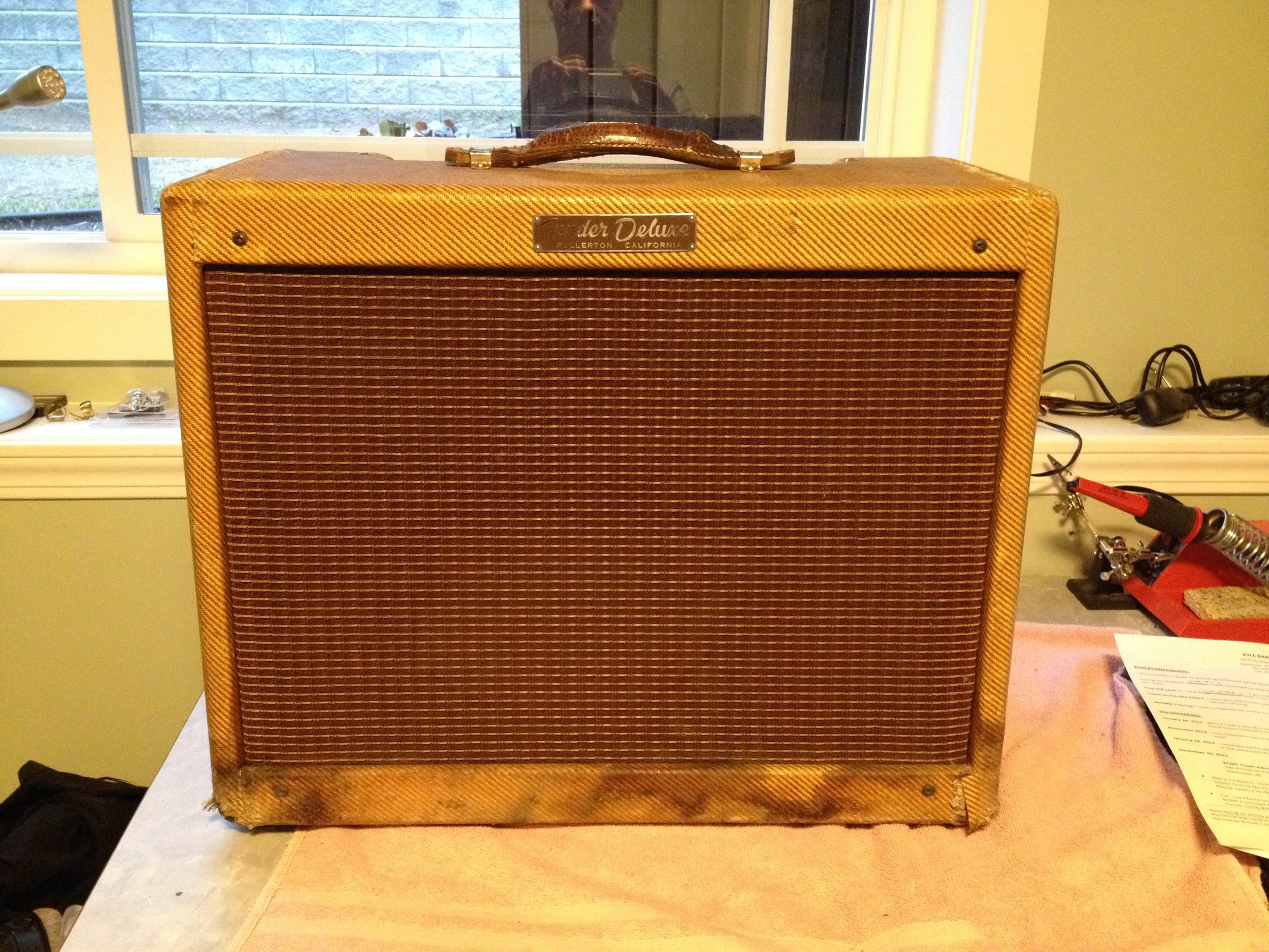
Photos past Keithb7.

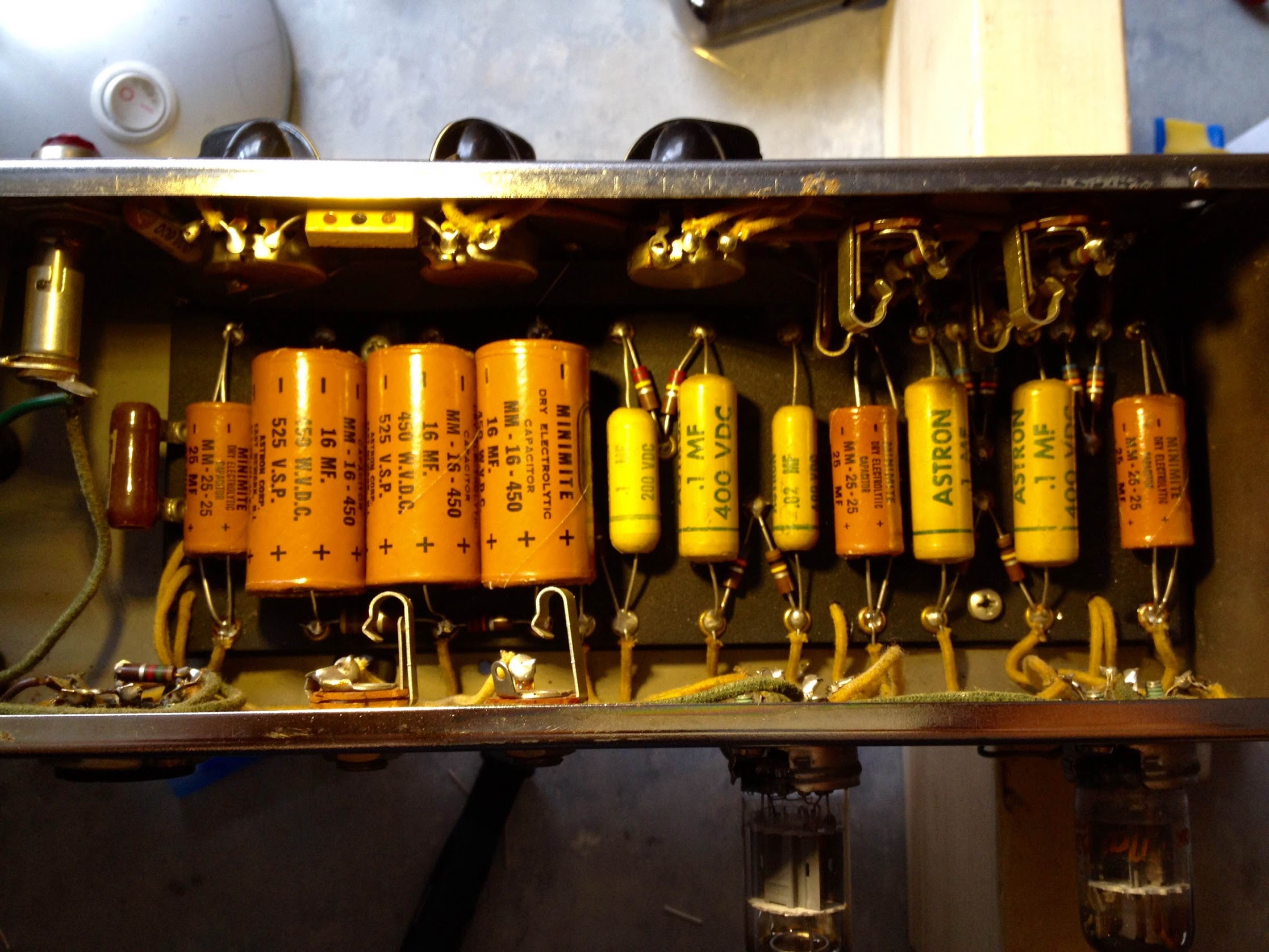
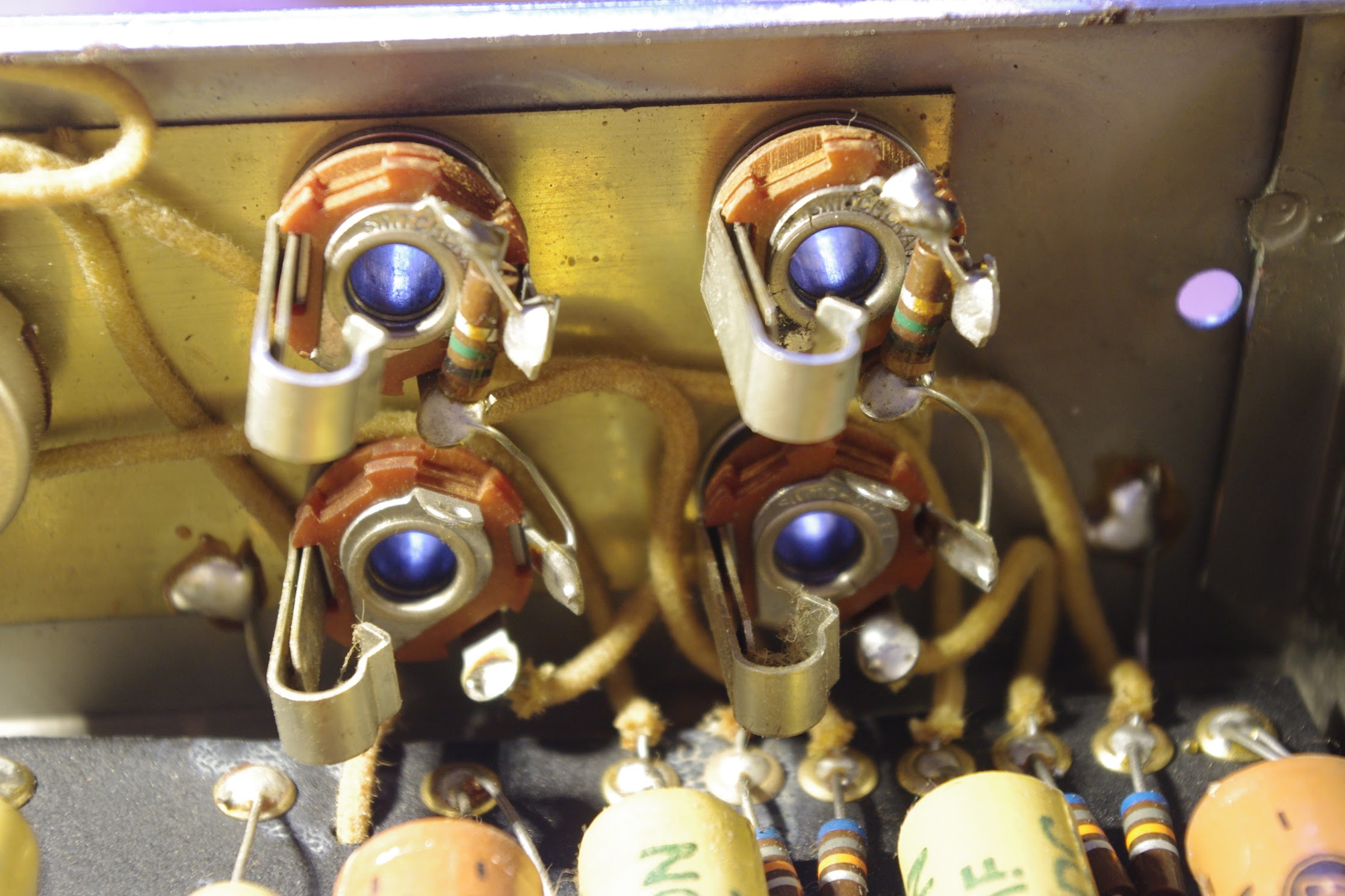
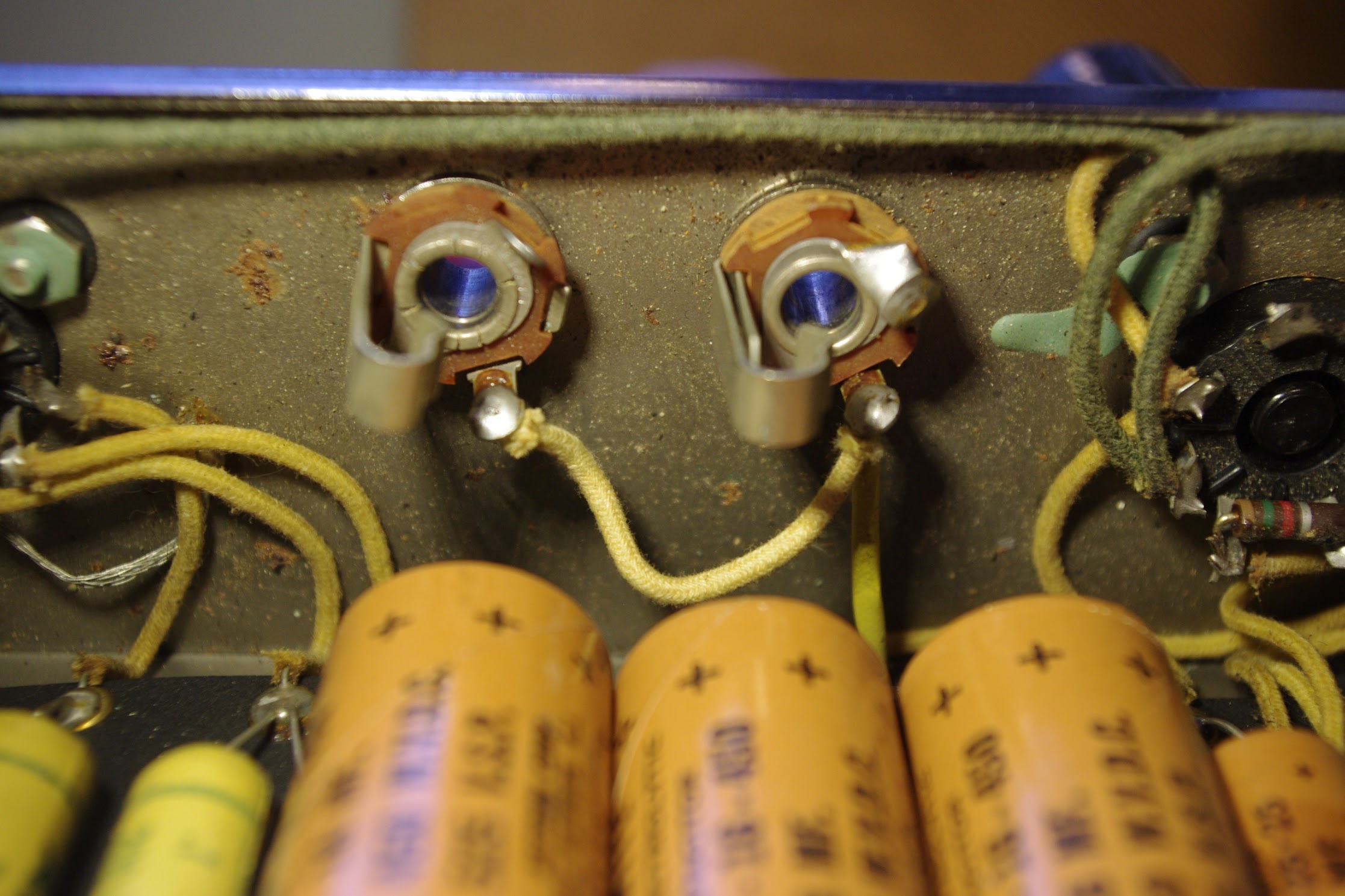
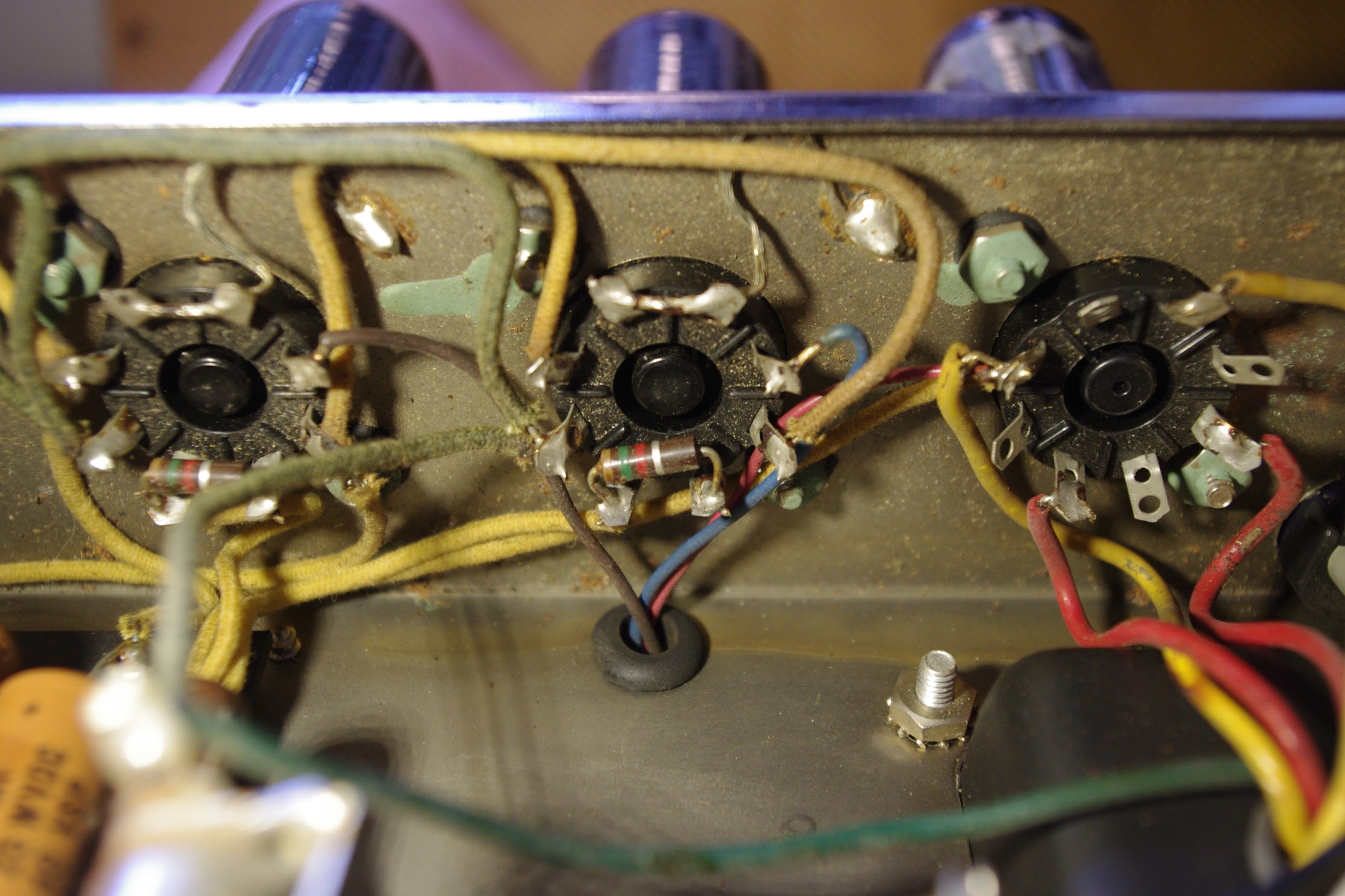
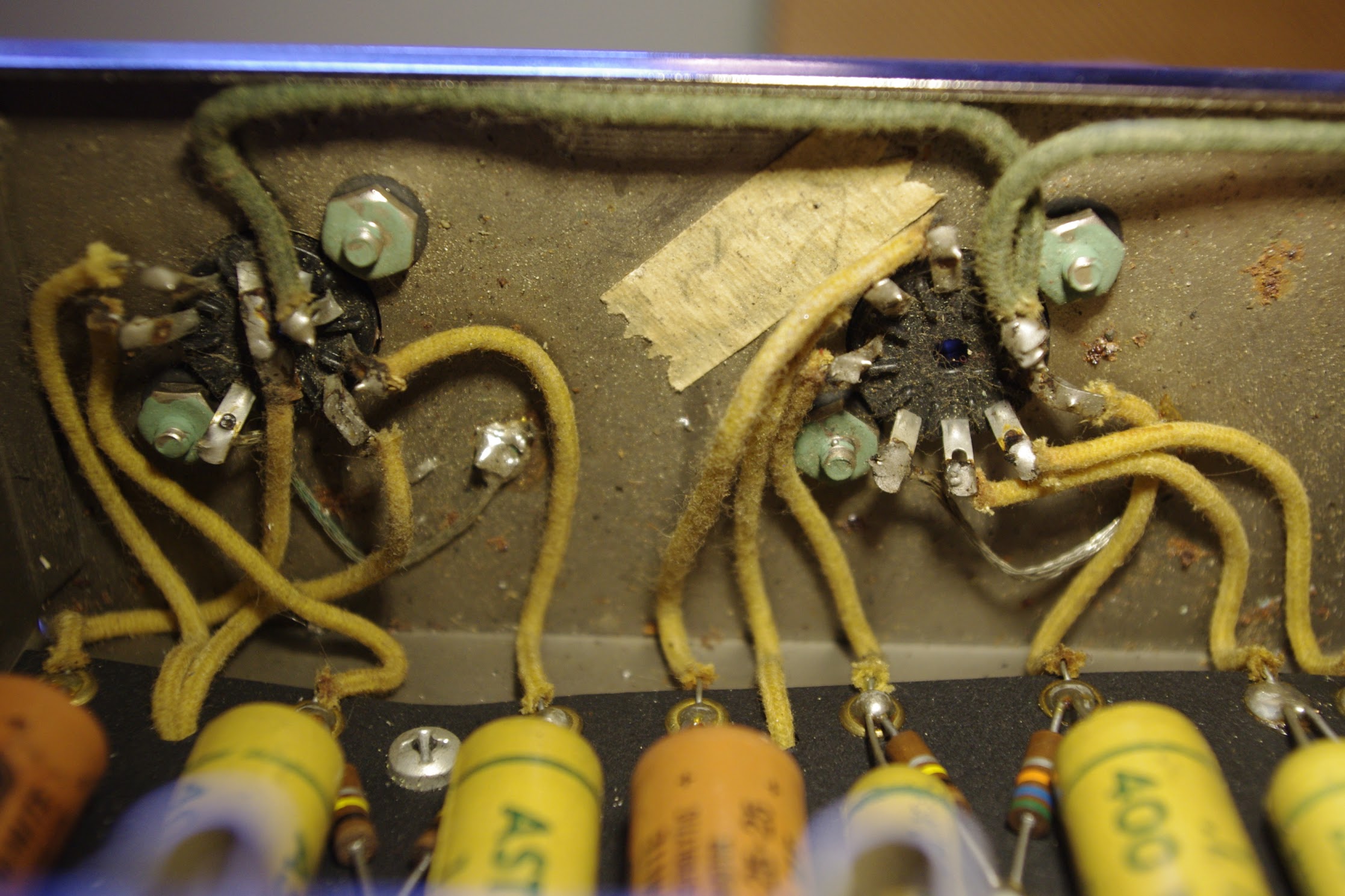

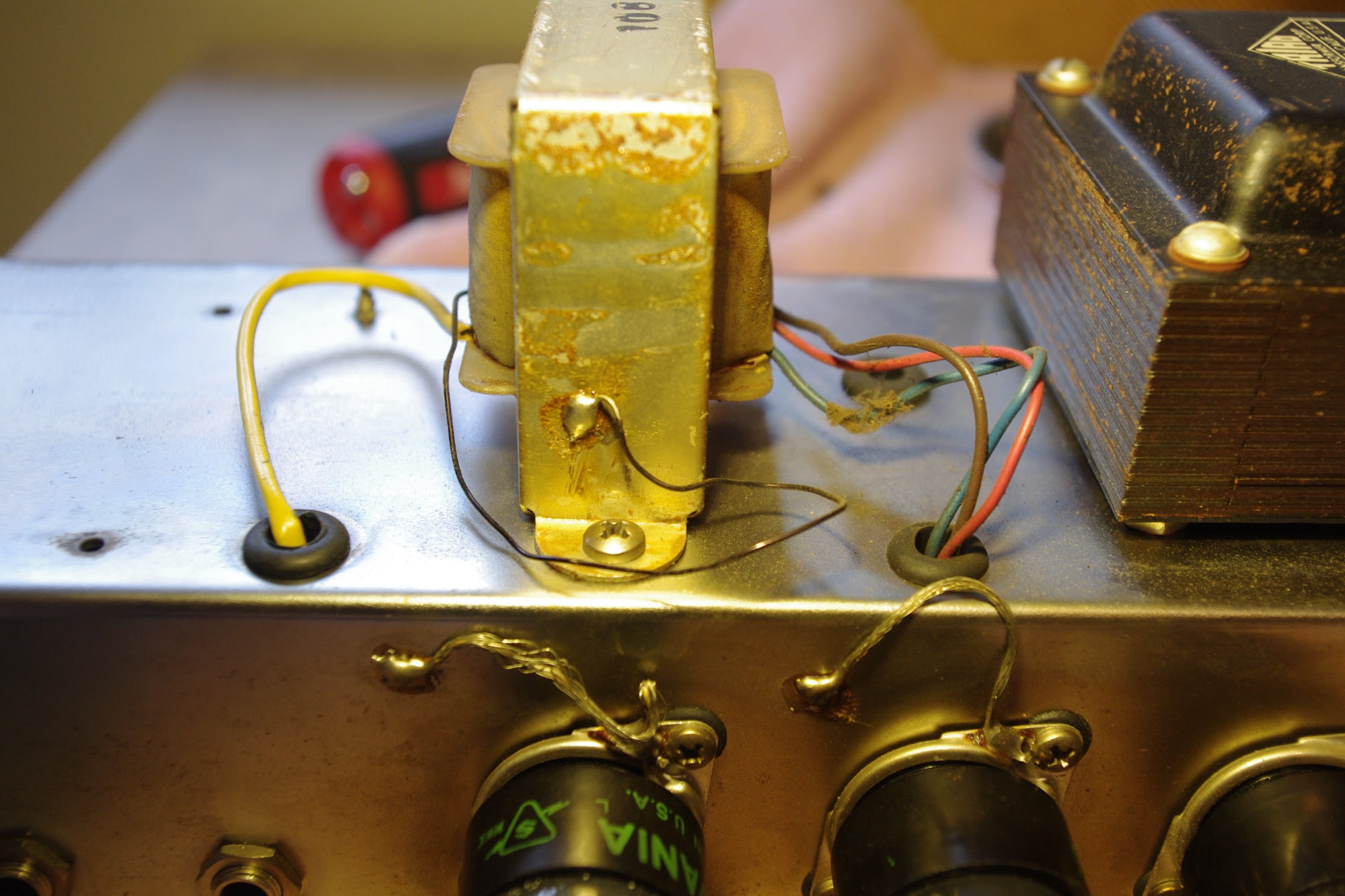
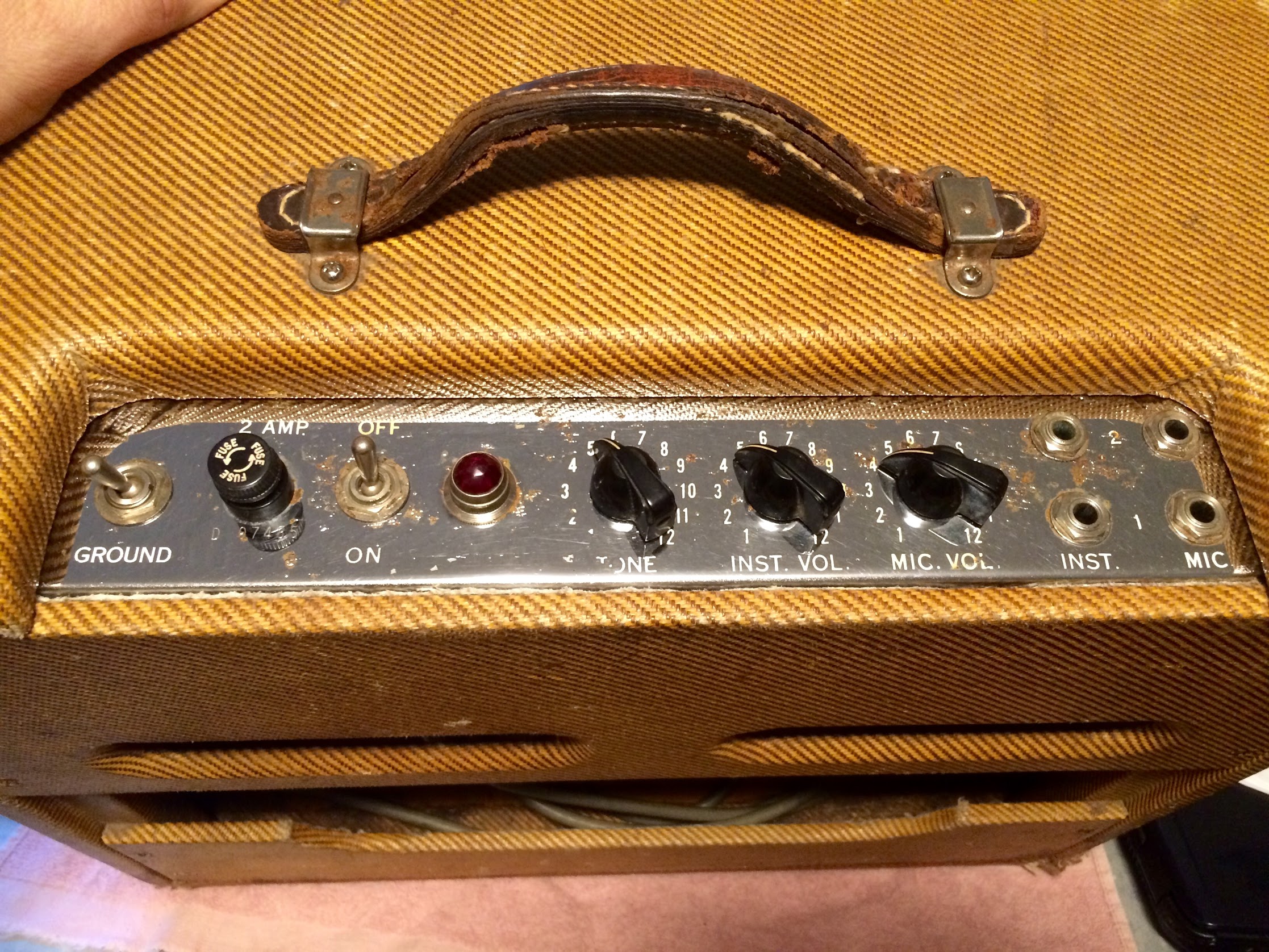
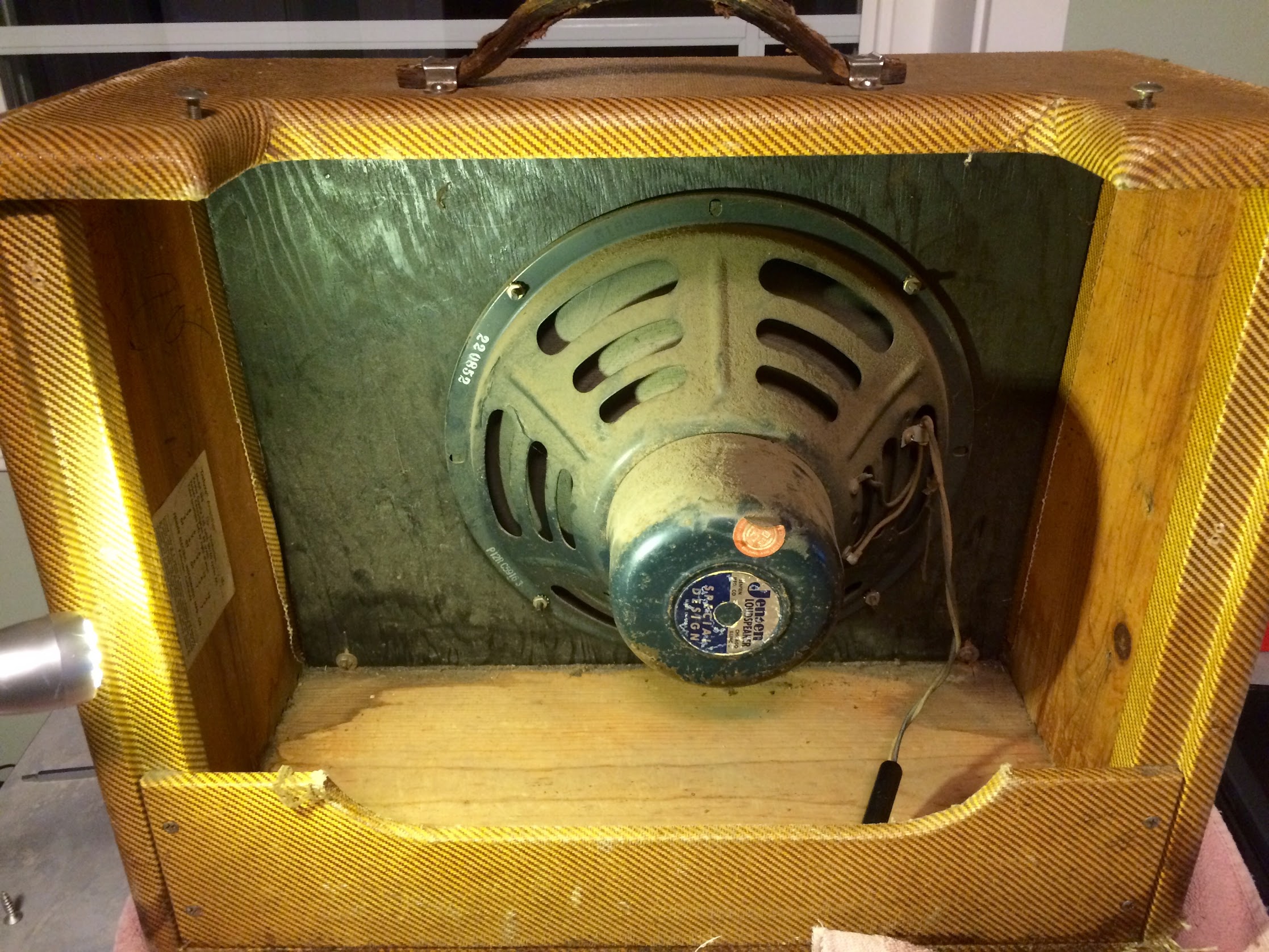
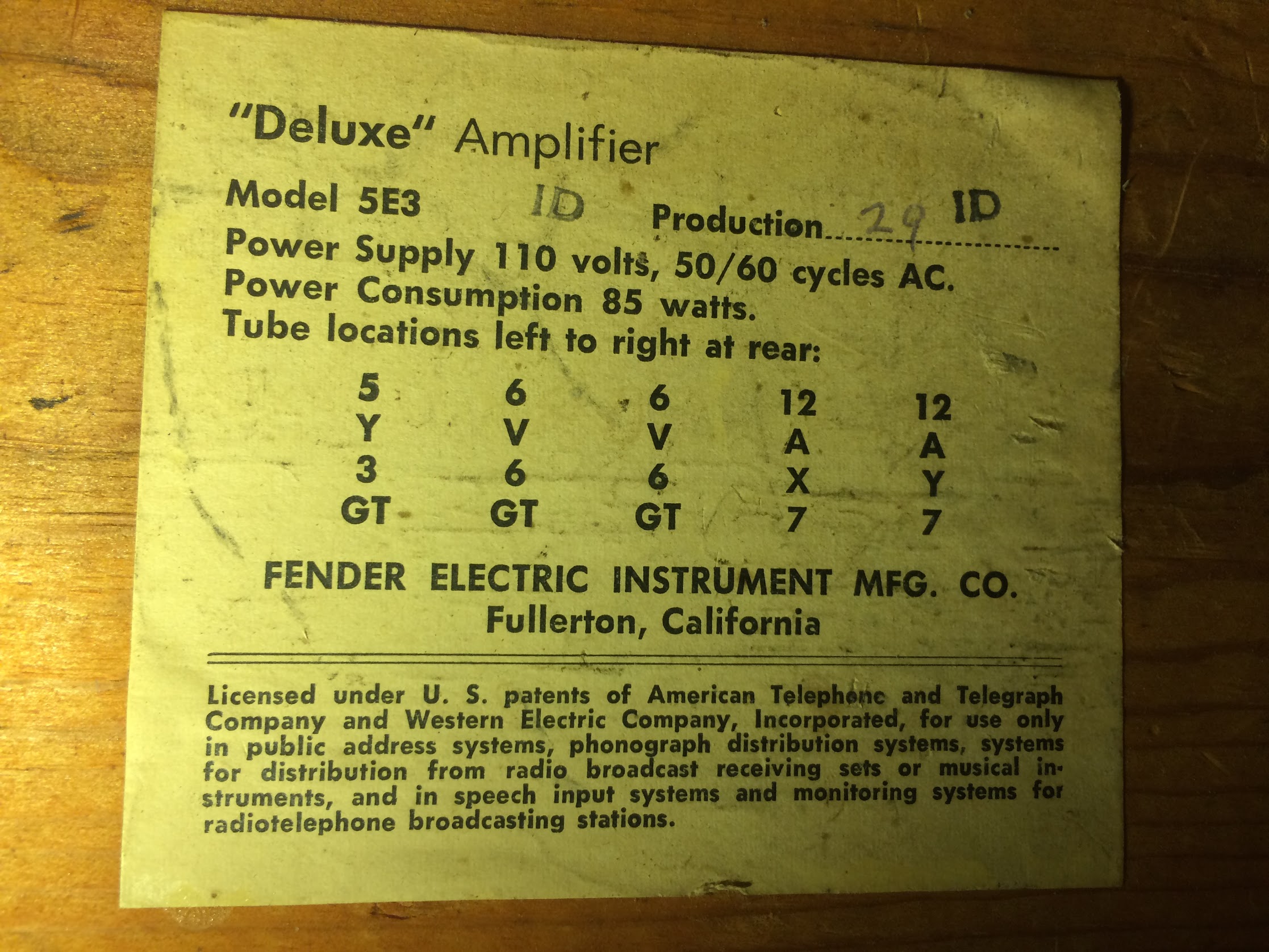
The tube chart within the cab. See this to make a reproduction chart.
Well that's information technology for the 5E3 Deluxe. It'due south a corking sounding but simple guitar amp.
Hither's a 5E3 Derived Big Bottle Amp From Weber
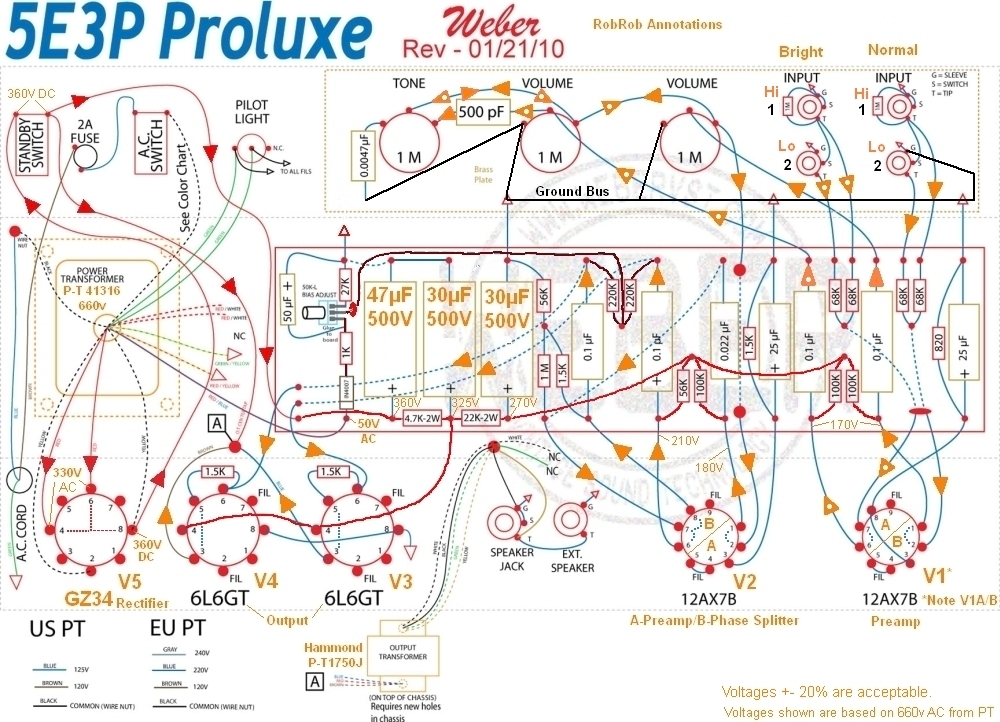
The 5E3P tweed Proluxe features a dual 6L6 tube push-pull output stage and fixed bias. It uses a higher voltage output GZ34 rectifier tube to give the 6L6 power tubes the higher voltage they similar. The betoken flow is identical to the 5E3 and is shown using orange arrows. Cerise arrows show the power flow. My showtime amp build was a BootHillAmps.com 5E3P.
By Rob Robinette
References
RCA Corporation, RCA Receiving Tube Manual, RC30.
Merlin Blencowe, Designing Tube Preamps for Guitar and Bass, 2nd Edition. This is my personal favorite tube amp book.
Merlin Blencowe, Designing High-Fidelity Tube Preamps
Morgan Jones, Valve Amplifiers, 4th Edition.
Richard Kuehnel, Circuit Assay of a Legendary Tube Amplifier: The Fender Bassman 5F6-A, 3rd Edition.
Richard Kuehnel, Vacuum Tube Circuit Design: Guitar Amplifier Preamps, 2d Edition.
Richard Kuehnel, Vacuum Tube Excursion Design: Guitar Amplifier Power Amps
Robert C. Megantz, Blueprint and Construction of Tube Guitar Amplifiers
Neumann & Irving, Guitar Amplifier Overdrive, A Visual Bout It's fairly technical but information technology's the only book written specifically nigh guitar amplifier overdrive. It includes many graphs to help brand the material easier to understand.
T.E. Rutt, Vacuum Tube Triode Nonlinearity equally Part of The Electric Guitar Audio
[ How Amps Piece of work ] [ Overdrive ] [ 5E3 Mods ] [ 5F6A Mods ] [ AB763 Mods ] [ DRRI & 68 CDR Mods ] [ How the 5E3 Deluxe Works ] [ How the AB763 Works ] [ AB763 Models ] [ Tube Bias Calculator ] [ Amp Troubleshooting ] [ Palatial Models ] [ Deluxe Micro Amp ] [ Bassman Micro Amp ] [ Champ Micro Amp ] [ My 5E3 Build ] [ Reverb & Tremolo ] [ SixShooter ] [ Spice Analysis ] [ VHT Special half dozen Ultra Mods ] [ Telecaster Mods ] [ Android Tube Bias Calculator App ] [ The Trainwreck Pages ] [ Fender Input Jacks ] [ B9A Epitome Board ]
Source: https://robrobinette.com/How_The_5E3_Deluxe_Works.htm

0 Response to "what do you hook up 5e3 ground switch to"
ارسال یک نظر